Caffeine Hub Project: Project Charter and Leadership Analysis
VerifiedAdded on 2023/06/08
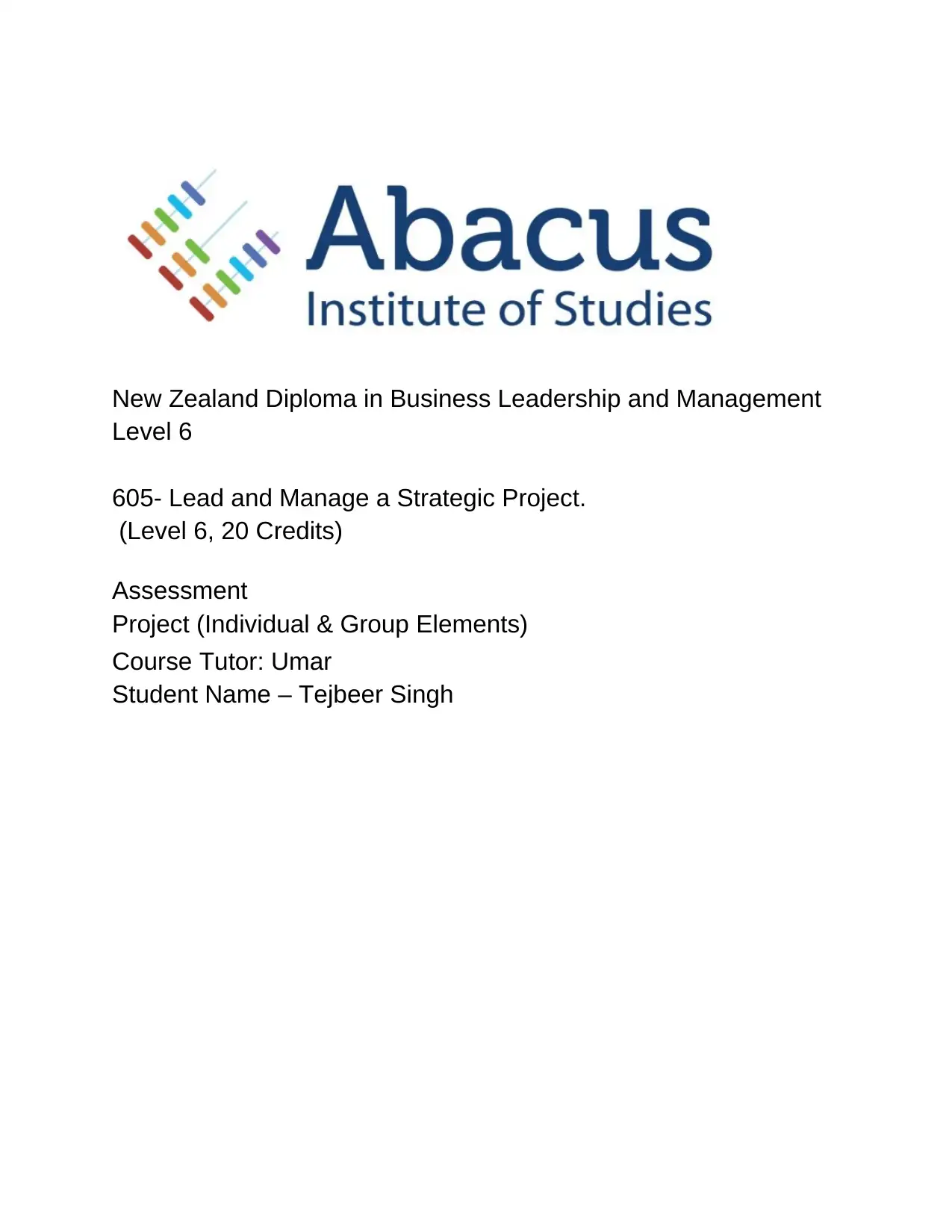
Level 6
605- Lead and Manage a Strategic Project.
(Level 6, 20 Credits)
Assessment
Project (Individual & Group Elements)
Course Tutor: Umar
Student Name – Tejbeer Singh
Paraphrase This Document
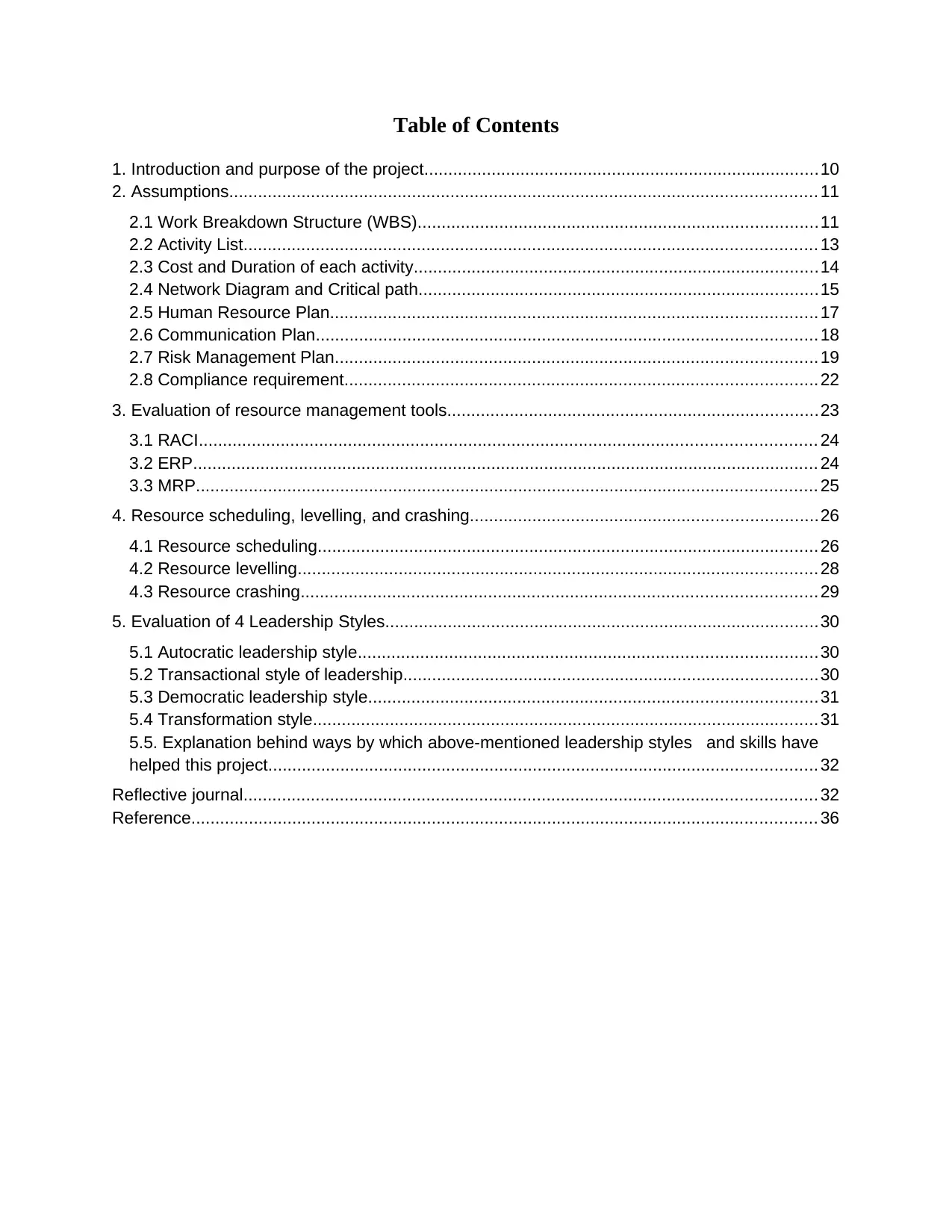
1. Introduction and purpose of the project..................................................................................10
2. Assumptions.......................................................................................................................... 11
2.1 Work Breakdown Structure (WBS)...................................................................................11
2.2 Activity List....................................................................................................................... 13
2.3 Cost and Duration of each activity....................................................................................14
2.4 Network Diagram and Critical path...................................................................................15
2.5 Human Resource Plan.....................................................................................................17
2.6 Communication Plan........................................................................................................18
2.7 Risk Management Plan....................................................................................................19
2.8 Compliance requirement..................................................................................................22
3. Evaluation of resource management tools.............................................................................23
3.1 RACI................................................................................................................................ 24
3.2 ERP.................................................................................................................................. 24
3.3 MRP................................................................................................................................. 25
4. Resource scheduling, levelling, and crashing........................................................................26
4.1 Resource scheduling........................................................................................................26
4.2 Resource levelling............................................................................................................ 28
4.3 Resource crashing........................................................................................................... 29
5. Evaluation of 4 Leadership Styles..........................................................................................30
5.1 Autocratic leadership style...............................................................................................30
5.2 Transactional style of leadership......................................................................................30
5.3 Democratic leadership style.............................................................................................31
5.4 Transformation style.........................................................................................................31
5.5. Explanation behind ways by which above-mentioned leadership styles and skills have
helped this project.................................................................................................................. 32
Reflective journal....................................................................................................................... 32
Reference.................................................................................................................................. 36
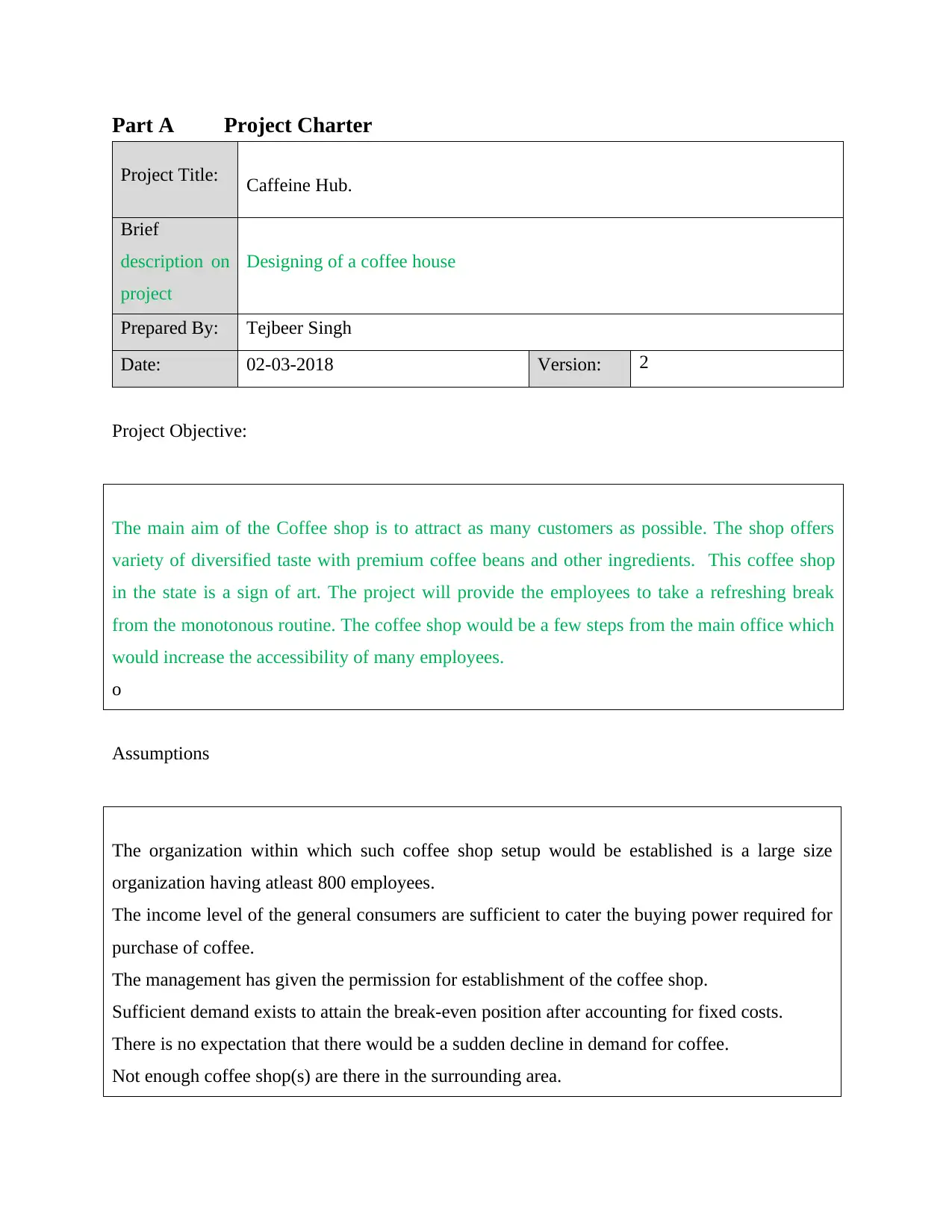
Project Title: Caffeine Hub.
Brief
description on
project
Designing of a coffee house
Prepared By: Tejbeer Singh
Date: 02-03-2018 Version: 2
Project Objective:
The main aim of the Coffee shop is to attract as many customers as possible. The shop offers
variety of diversified taste with premium coffee beans and other ingredients. This coffee shop
in the state is a sign of art. The project will provide the employees to take a refreshing break
from the monotonous routine. The coffee shop would be a few steps from the main office which
would increase the accessibility of many employees.
o
Assumptions
The organization within which such coffee shop setup would be established is a large size
organization having atleast 800 employees.
The income level of the general consumers are sufficient to cater the buying power required for
purchase of coffee.
The management has given the permission for establishment of the coffee shop.
Sufficient demand exists to attain the break-even position after accounting for fixed costs.
There is no expectation that there would be a sudden decline in demand for coffee.
Not enough coffee shop(s) are there in the surrounding area.
⊘ This is a preview!⊘
Do you want full access?
Subscribe today to unlock all pages.

Trusted by 1+ million students worldwide
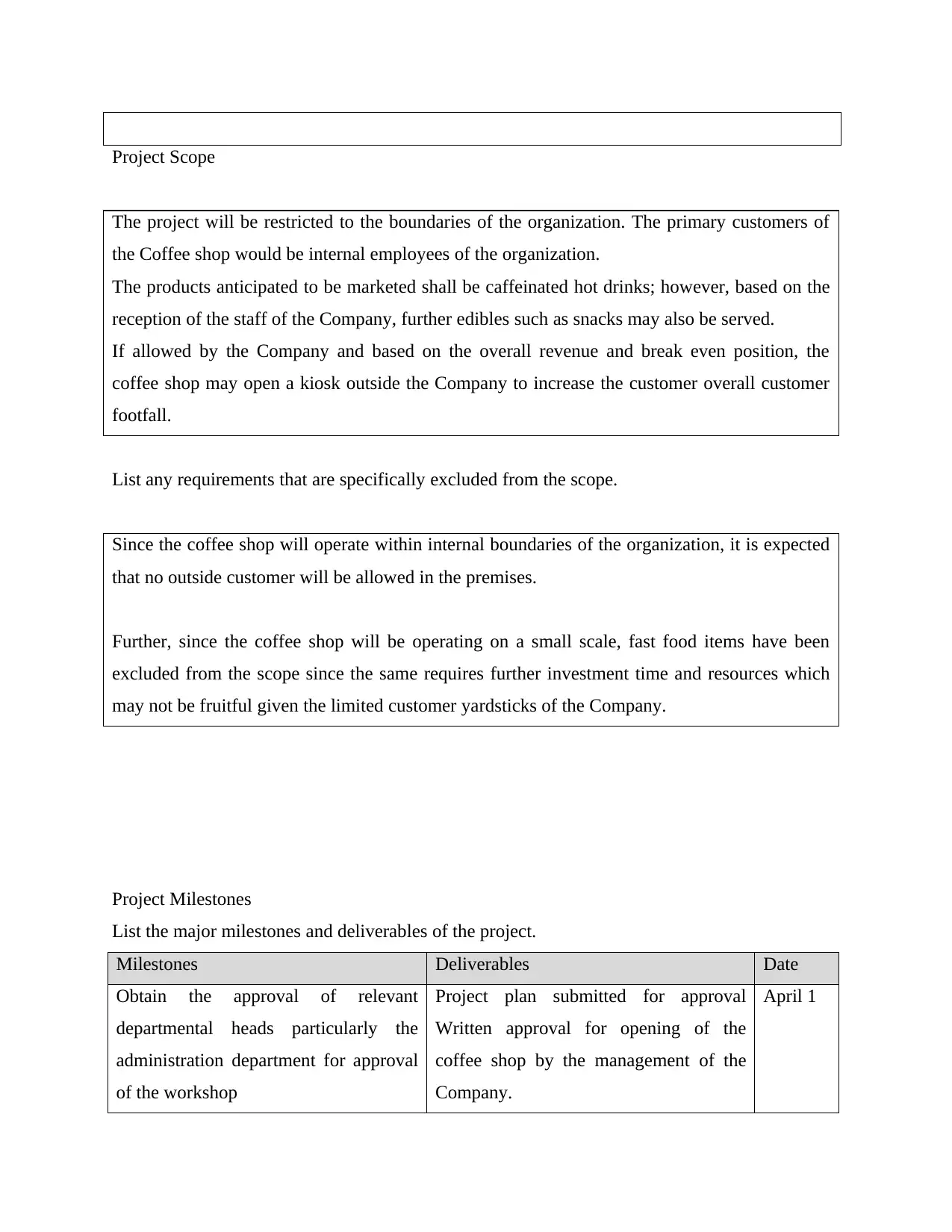
The project will be restricted to the boundaries of the organization. The primary customers of
the Coffee shop would be internal employees of the organization.
The products anticipated to be marketed shall be caffeinated hot drinks; however, based on the
reception of the staff of the Company, further edibles such as snacks may also be served.
If allowed by the Company and based on the overall revenue and break even position, the
coffee shop may open a kiosk outside the Company to increase the customer overall customer
footfall.
List any requirements that are specifically excluded from the scope.
Since the coffee shop will operate within internal boundaries of the organization, it is expected
that no outside customer will be allowed in the premises.
Further, since the coffee shop will be operating on a small scale, fast food items have been
excluded from the scope since the same requires further investment time and resources which
may not be fruitful given the limited customer yardsticks of the Company.
Project Milestones
List the major milestones and deliverables of the project.
Milestones Deliverables Date
Obtain the approval of relevant
departmental heads particularly the
administration department for approval
of the workshop
Project plan submitted for approval
Written approval for opening of the
coffee shop by the management of the
Company.
April 1
Paraphrase This Document
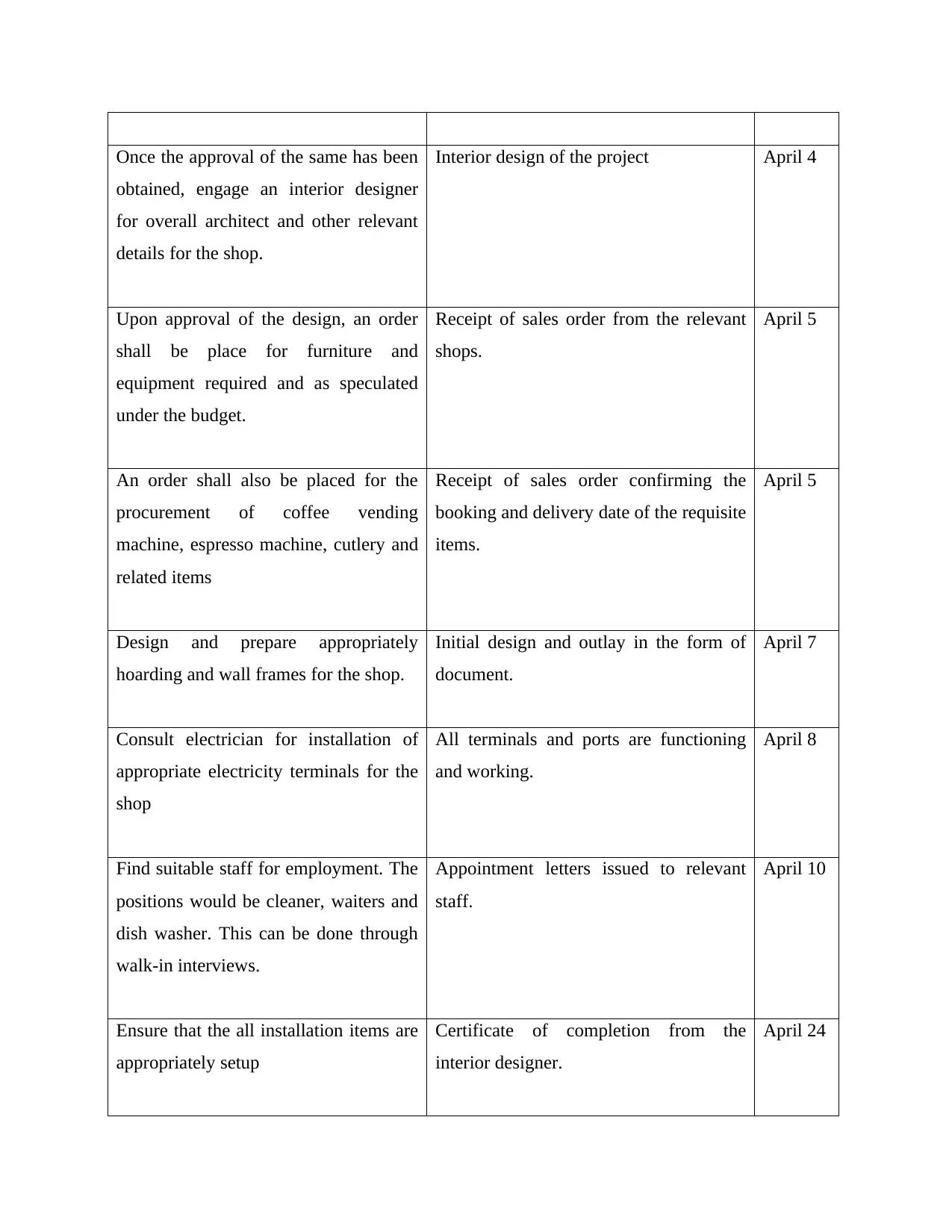
obtained, engage an interior designer
for overall architect and other relevant
details for the shop.
Interior design of the project April 4
Upon approval of the design, an order
shall be place for furniture and
equipment required and as speculated
under the budget.
Receipt of sales order from the relevant
shops.
April 5
An order shall also be placed for the
procurement of coffee vending
machine, espresso machine, cutlery and
related items
Receipt of sales order confirming the
booking and delivery date of the requisite
items.
April 5
Design and prepare appropriately
hoarding and wall frames for the shop.
Initial design and outlay in the form of
document.
April 7
Consult electrician for installation of
appropriate electricity terminals for the
shop
All terminals and ports are functioning
and working.
April 8
Find suitable staff for employment. The
positions would be cleaner, waiters and
dish washer. This can be done through
walk-in interviews.
Appointment letters issued to relevant
staff.
April 10
Ensure that the all installation items are
appropriately setup
Certificate of completion from the
interior designer.
April 24
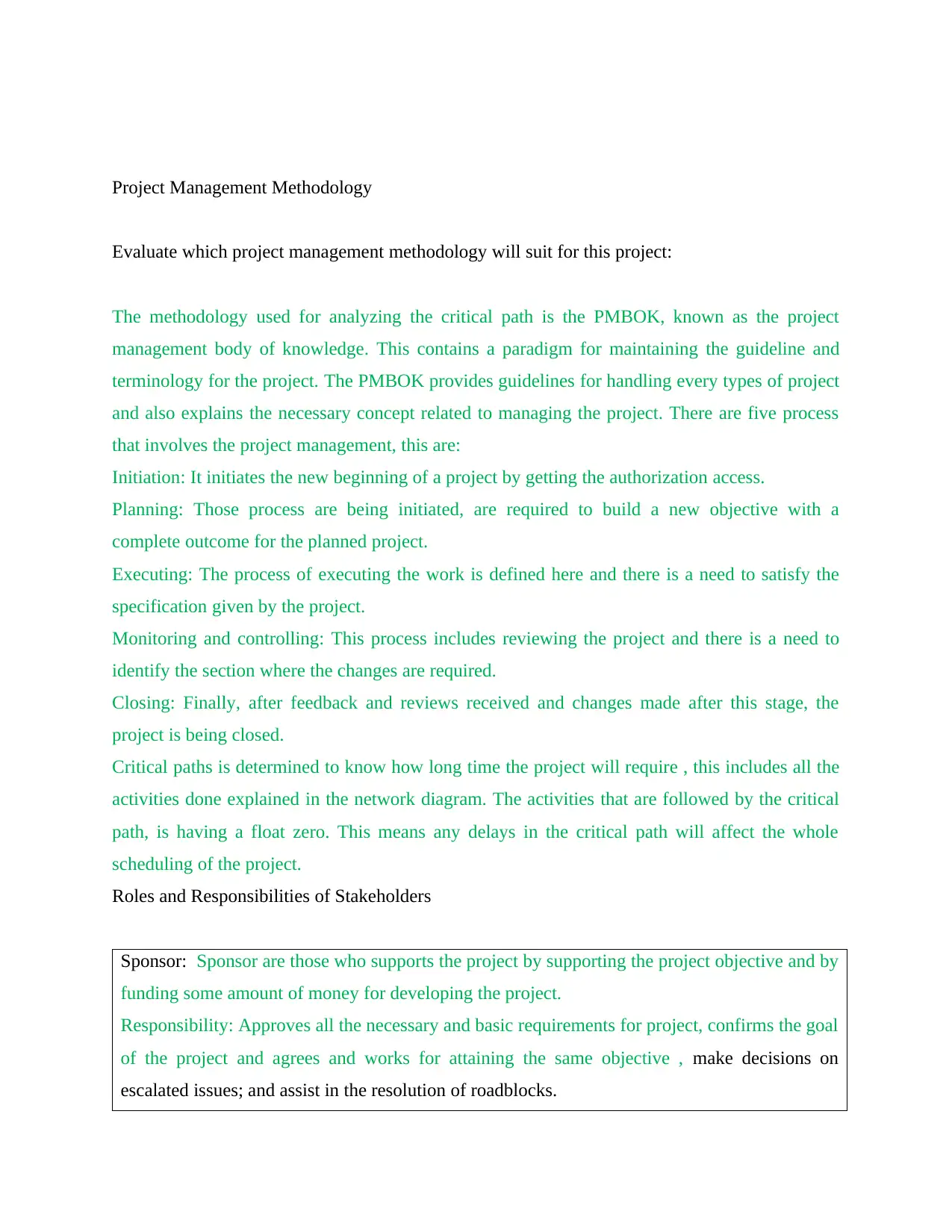
Evaluate which project management methodology will suit for this project:
The methodology used for analyzing the critical path is the PMBOK, known as the project
management body of knowledge. This contains a paradigm for maintaining the guideline and
terminology for the project. The PMBOK provides guidelines for handling every types of project
and also explains the necessary concept related to managing the project. There are five process
that involves the project management, this are:
Initiation: It initiates the new beginning of a project by getting the authorization access.
Planning: Those process are being initiated, are required to build a new objective with a
complete outcome for the planned project.
Executing: The process of executing the work is defined here and there is a need to satisfy the
specification given by the project.
Monitoring and controlling: This process includes reviewing the project and there is a need to
identify the section where the changes are required.
Closing: Finally, after feedback and reviews received and changes made after this stage, the
project is being closed.
Critical paths is determined to know how long time the project will require , this includes all the
activities done explained in the network diagram. The activities that are followed by the critical
path, is having a float zero. This means any delays in the critical path will affect the whole
scheduling of the project.
Roles and Responsibilities of Stakeholders
Sponsor: Sponsor are those who supports the project by supporting the project objective and by
funding some amount of money for developing the project.
Responsibility: Approves all the necessary and basic requirements for project, confirms the goal
of the project and agrees and works for attaining the same objective , make decisions on
escalated issues; and assist in the resolution of roadblocks.
⊘ This is a preview!⊘
Do you want full access?
Subscribe today to unlock all pages.

Trusted by 1+ million students worldwide
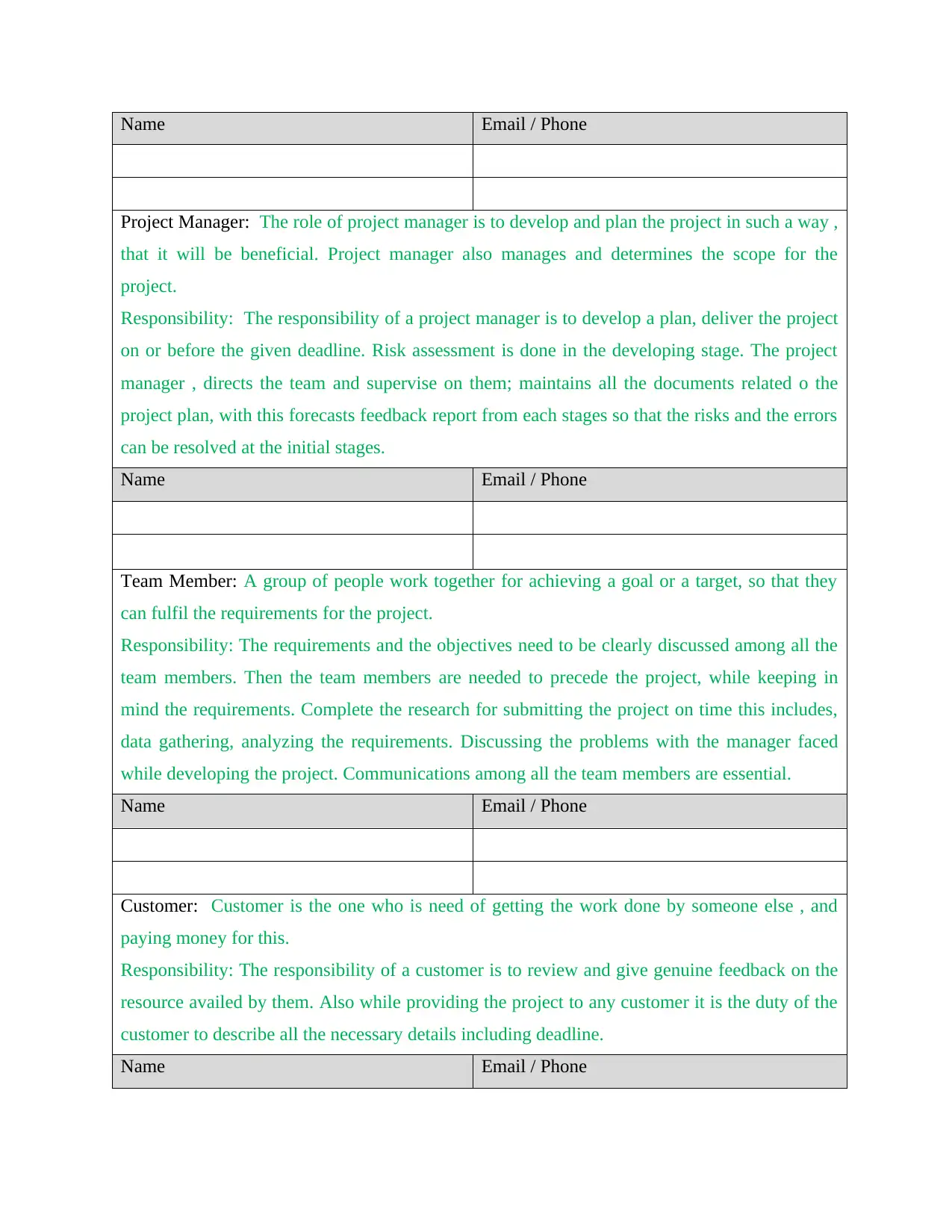
Project Manager: The role of project manager is to develop and plan the project in such a way ,
that it will be beneficial. Project manager also manages and determines the scope for the
project.
Responsibility: The responsibility of a project manager is to develop a plan, deliver the project
on or before the given deadline. Risk assessment is done in the developing stage. The project
manager , directs the team and supervise on them; maintains all the documents related o the
project plan, with this forecasts feedback report from each stages so that the risks and the errors
can be resolved at the initial stages.
Name Email / Phone
Team Member: A group of people work together for achieving a goal or a target, so that they
can fulfil the requirements for the project.
Responsibility: The requirements and the objectives need to be clearly discussed among all the
team members. Then the team members are needed to precede the project, while keeping in
mind the requirements. Complete the research for submitting the project on time this includes,
data gathering, analyzing the requirements. Discussing the problems with the manager faced
while developing the project. Communications among all the team members are essential.
Name Email / Phone
Customer: Customer is the one who is need of getting the work done by someone else , and
paying money for this.
Responsibility: The responsibility of a customer is to review and give genuine feedback on the
resource availed by them. Also while providing the project to any customer it is the duty of the
customer to describe all the necessary details including deadline.
Name Email / Phone
Paraphrase This Document
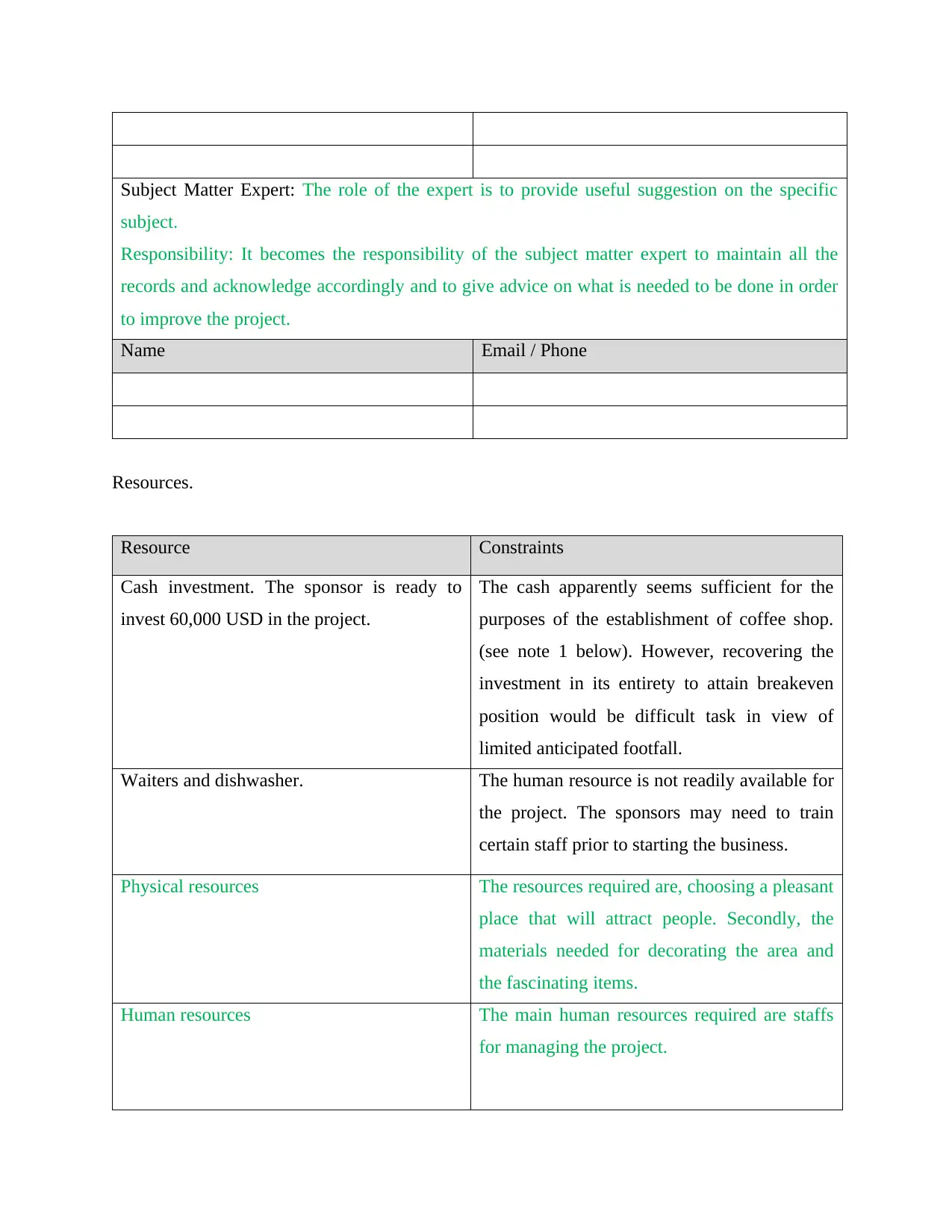
subject.
Responsibility: It becomes the responsibility of the subject matter expert to maintain all the
records and acknowledge accordingly and to give advice on what is needed to be done in order
to improve the project.
Name Email / Phone
Resources.
Resource Constraints
Cash investment. The sponsor is ready to
invest 60,000 USD in the project.
The cash apparently seems sufficient for the
purposes of the establishment of coffee shop.
(see note 1 below). However, recovering the
investment in its entirety to attain breakeven
position would be difficult task in view of
limited anticipated footfall.
Waiters and dishwasher. The human resource is not readily available for
the project. The sponsors may need to train
certain staff prior to starting the business.
Physical resources The resources required are, choosing a pleasant
place that will attract people. Secondly, the
materials needed for decorating the area and
the fascinating items.
Human resources The main human resources required are staffs
for managing the project.
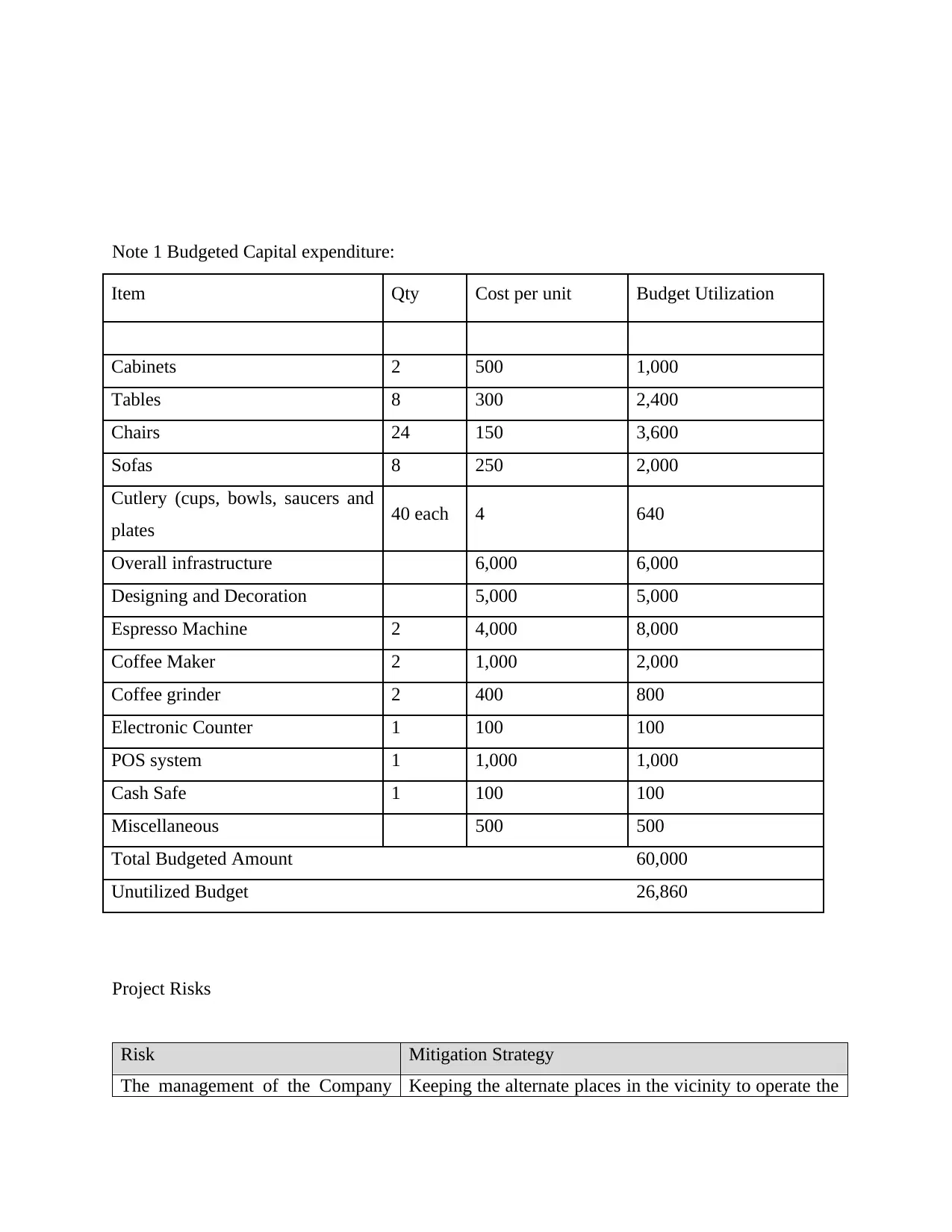
Item Qty Cost per unit Budget Utilization
Cabinets 2 500 1,000
Tables 8 300 2,400
Chairs 24 150 3,600
Sofas 8 250 2,000
Cutlery (cups, bowls, saucers and
plates 40 each 4 640
Overall infrastructure 6,000 6,000
Designing and Decoration 5,000 5,000
Espresso Machine 2 4,000 8,000
Coffee Maker 2 1,000 2,000
Coffee grinder 2 400 800
Electronic Counter 1 100 100
POS system 1 1,000 1,000
Cash Safe 1 100 100
Miscellaneous 500 500
Total Budgeted Amount 60,000
Unutilized Budget 26,860
Project Risks
Risk Mitigation Strategy
The management of the Company Keeping the alternate places in the vicinity to operate the
⊘ This is a preview!⊘
Do you want full access?
Subscribe today to unlock all pages.

Trusted by 1+ million students worldwide

decision to continue allowing the
use of coffee shop
coffee shop for which the rent is minimal
The employees may prefer buying
the coffee from outside due to
premium brand or taste resulting in
losses on account of fixed costs.
Ensuring the high quality of services and product to
continuous evaluation of vendors and recipes. The
evaluations can be conducted through reviews of
customers.
The employees may not be fond of
coffee due to which the losses on
account of fixed cost may be
incurred
Keeping in line options to introduce additional snacks
and caffeinated drinks or juices.
Foods prepared should be fresh
else the customer may complain
about the service.
Maintaining high level of quality standard through use of
high quality material.
It may not be easy to find suitable
vendors for the import of coffee
beans. Finding a vendor with ability
to provide quality coffee beans is a
difficult process.
Initial samples should be invited from different vendors.
The quality of the same should also be evaluated for
recurring purchases.
The biggest challenge is the overall
outlook and presentation of the
coffee shops. There is a possibility
that the un-appealing environment
may not be able to attract sufficient
employee customers.
Periodically making capital expenditure on the coffees
shop.
Another issue is that the Coffee
shop will be within the closed doors
of the Company. Due to this reason
the customers of the Company are
very limited.
Different products along with the coffee shop should be
marketed. If feasible and allowed by the Company,
provision may also be made for deliveries on order or
extra kiosk outside the office premises.
It is difficult to find sufficiently Providing annual training to employees and leading them
Paraphrase This Document
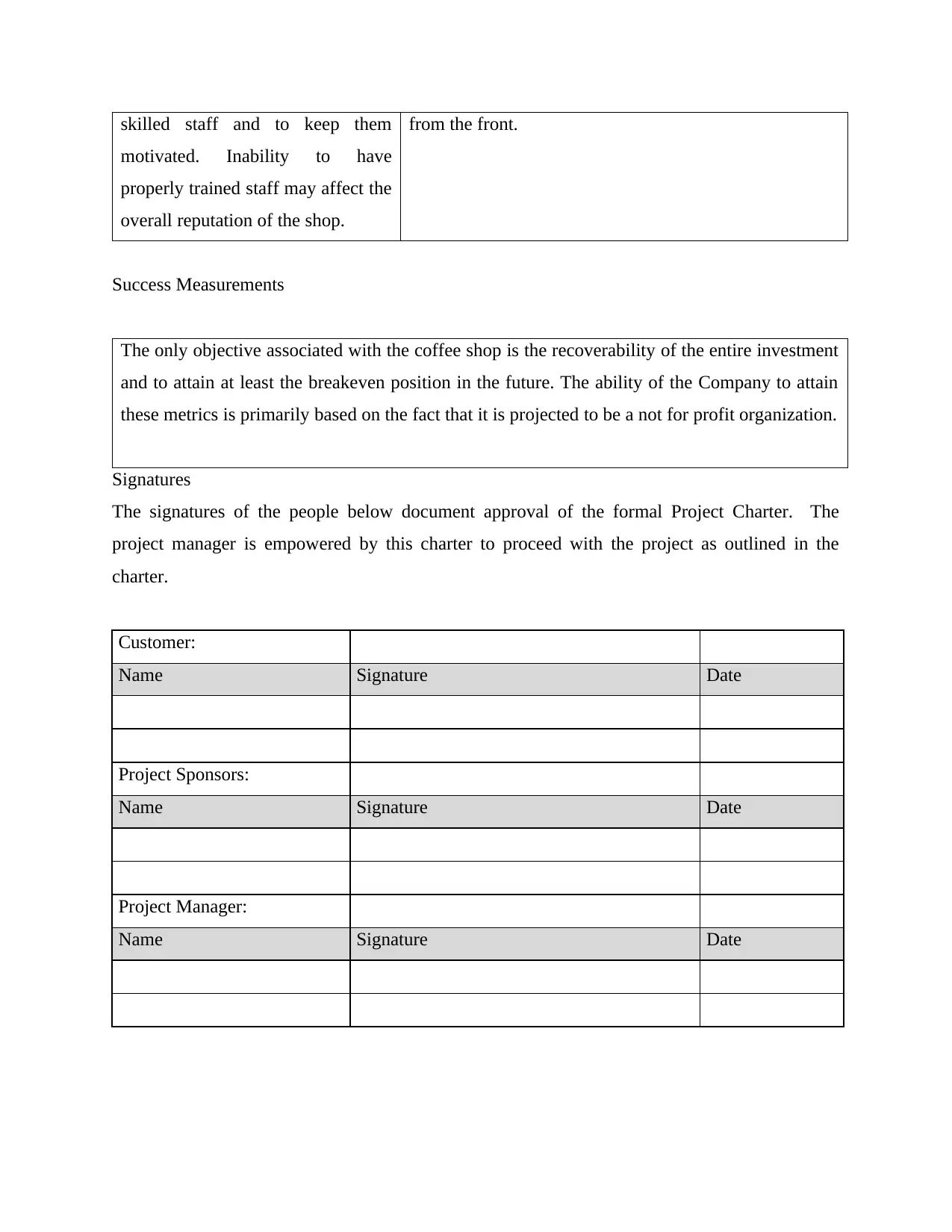
motivated. Inability to have
properly trained staff may affect the
overall reputation of the shop.
from the front.
Success Measurements
The only objective associated with the coffee shop is the recoverability of the entire investment
and to attain at least the breakeven position in the future. The ability of the Company to attain
these metrics is primarily based on the fact that it is projected to be a not for profit organization.
Signatures
The signatures of the people below document approval of the formal Project Charter. The
project manager is empowered by this charter to proceed with the project as outlined in the
charter.
Customer:
Name Signature Date
Project Sponsors:
Name Signature Date
Project Manager:
Name Signature Date
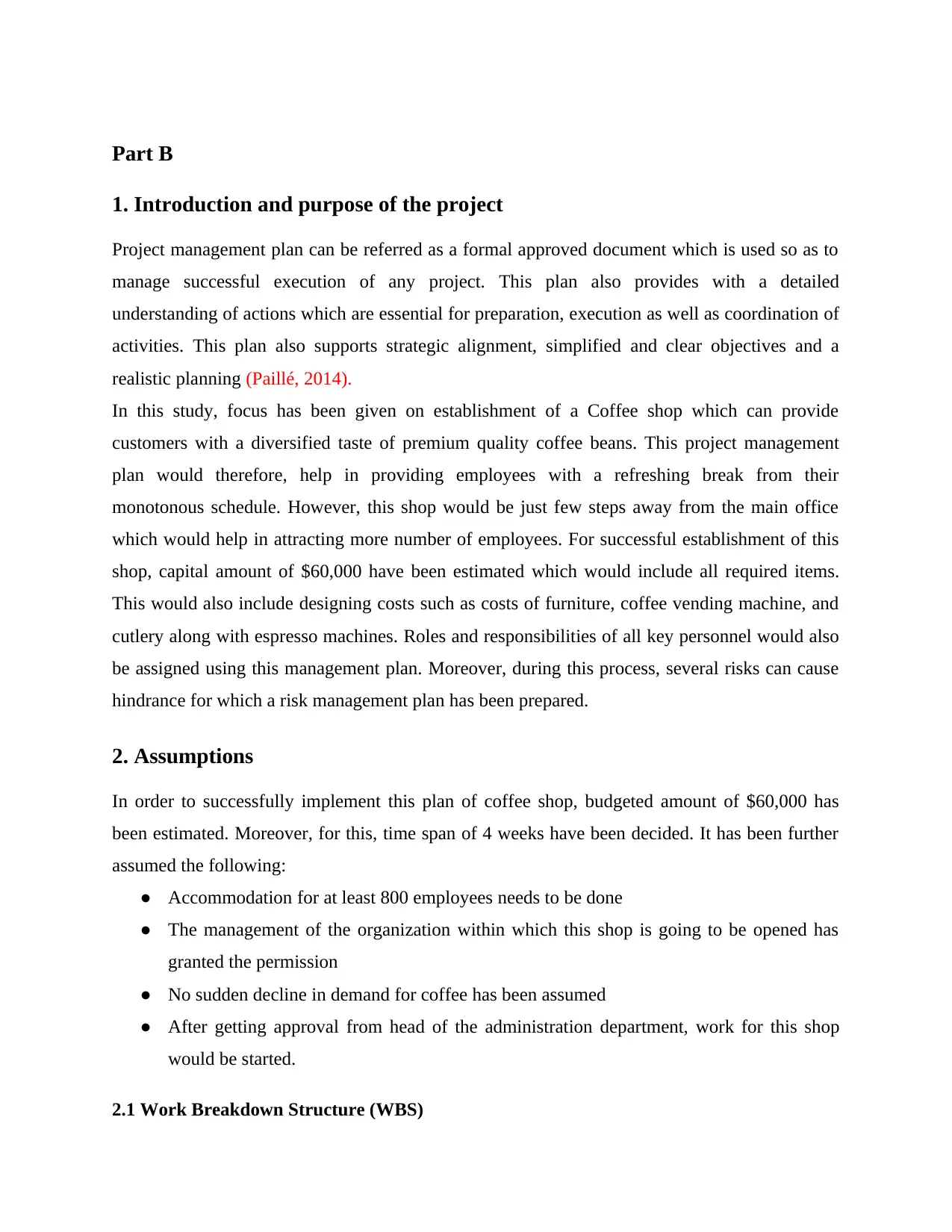
1. Introduction and purpose of the project
Project management plan can be referred as a formal approved document which is used so as to
manage successful execution of any project. This plan also provides with a detailed
understanding of actions which are essential for preparation, execution as well as coordination of
activities. This plan also supports strategic alignment, simplified and clear objectives and a
realistic planning (Paillé, 2014).
In this study, focus has been given on establishment of a Coffee shop which can provide
customers with a diversified taste of premium quality coffee beans. This project management
plan would therefore, help in providing employees with a refreshing break from their
monotonous schedule. However, this shop would be just few steps away from the main office
which would help in attracting more number of employees. For successful establishment of this
shop, capital amount of $60,000 have been estimated which would include all required items.
This would also include designing costs such as costs of furniture, coffee vending machine, and
cutlery along with espresso machines. Roles and responsibilities of all key personnel would also
be assigned using this management plan. Moreover, during this process, several risks can cause
hindrance for which a risk management plan has been prepared.
2. Assumptions
In order to successfully implement this plan of coffee shop, budgeted amount of $60,000 has
been estimated. Moreover, for this, time span of 4 weeks have been decided. It has been further
assumed the following:
● Accommodation for at least 800 employees needs to be done
● The management of the organization within which this shop is going to be opened has
granted the permission
● No sudden decline in demand for coffee has been assumed
● After getting approval from head of the administration department, work for this shop
would be started.
2.1 Work Breakdown Structure (WBS)
⊘ This is a preview!⊘
Do you want full access?
Subscribe today to unlock all pages.

Trusted by 1+ million students worldwide
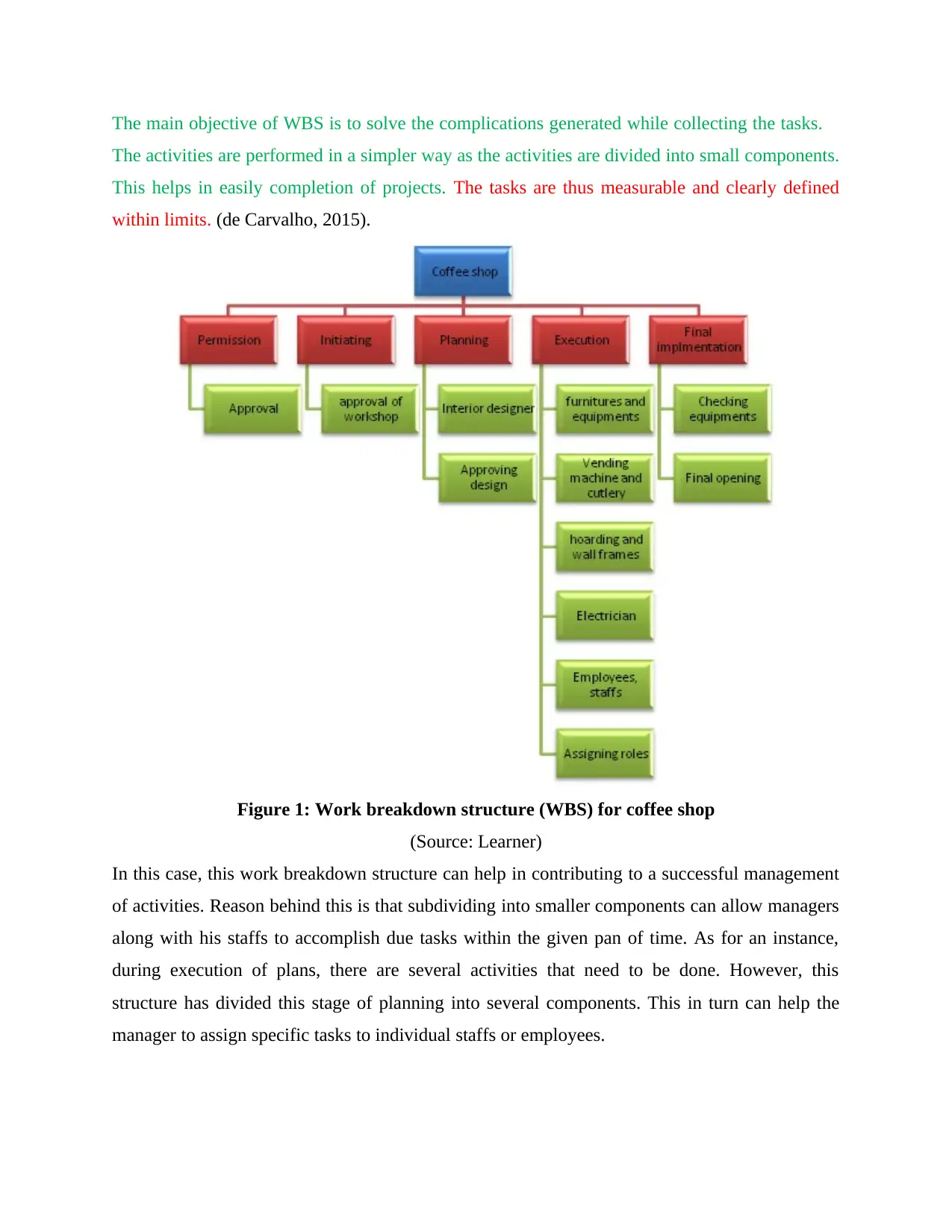
The activities are performed in a simpler way as the activities are divided into small components.
This helps in easily completion of projects. The tasks are thus measurable and clearly defined
within limits. (de Carvalho, 2015).
Figure 1: Work breakdown structure (WBS) for coffee shop
(Source: Learner)
In this case, this work breakdown structure can help in contributing to a successful management
of activities. Reason behind this is that subdividing into smaller components can allow managers
along with his staffs to accomplish due tasks within the given pan of time. As for an instance,
during execution of plans, there are several activities that need to be done. However, this
structure has divided this stage of planning into several components. This in turn can help the
manager to assign specific tasks to individual staffs or employees.
Paraphrase This Document

Figure 2: List of key activities
(Source: Learner)
Serial no. List of activities Dependencies
1 Approval from the administration department head
2 Final Approval A
3 Selection of an interior designer A, B
4 Approving the selected design of the designer 6
5 Ordering of furniture and other required equipments 6,7
6 Ordering of coffee vending machine, espresso machine, cutlery 6
7 Designing of hoarding and wall frames for the shop A, B
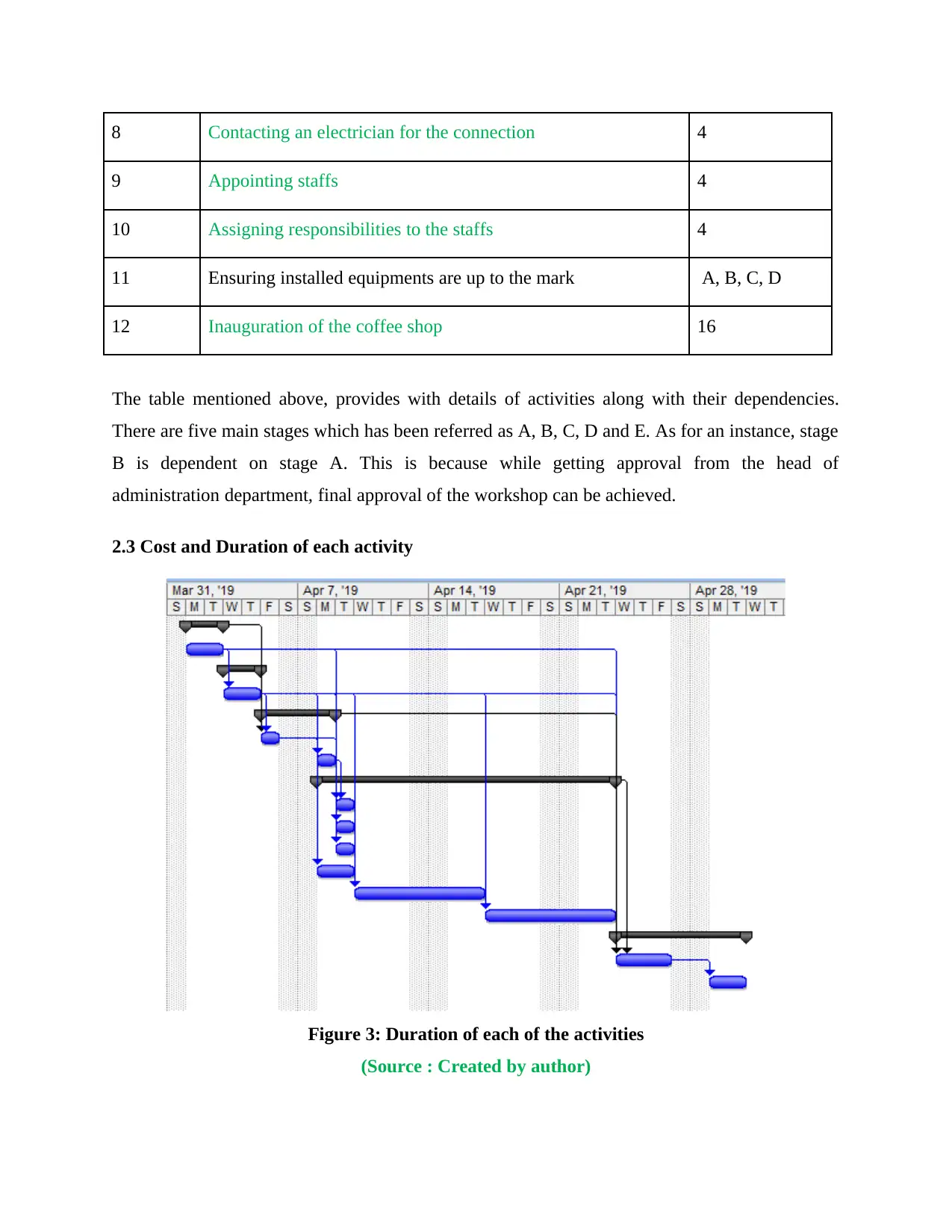
9 Appointing staffs 4
10 Assigning responsibilities to the staffs 4
11 Ensuring installed equipments are up to the mark A, B, C, D
12 Inauguration of the coffee shop 16
The table mentioned above, provides with details of activities along with their dependencies.
There are five main stages which has been referred as A, B, C, D and E. As for an instance, stage
B is dependent on stage A. This is because while getting approval from the head of
administration department, final approval of the workshop can be achieved.
2.3 Cost and Duration of each activity
Figure 3: Duration of each of the activities
(Source : Created by author)
⊘ This is a preview!⊘
Do you want full access?
Subscribe today to unlock all pages.

Trusted by 1+ million students worldwide
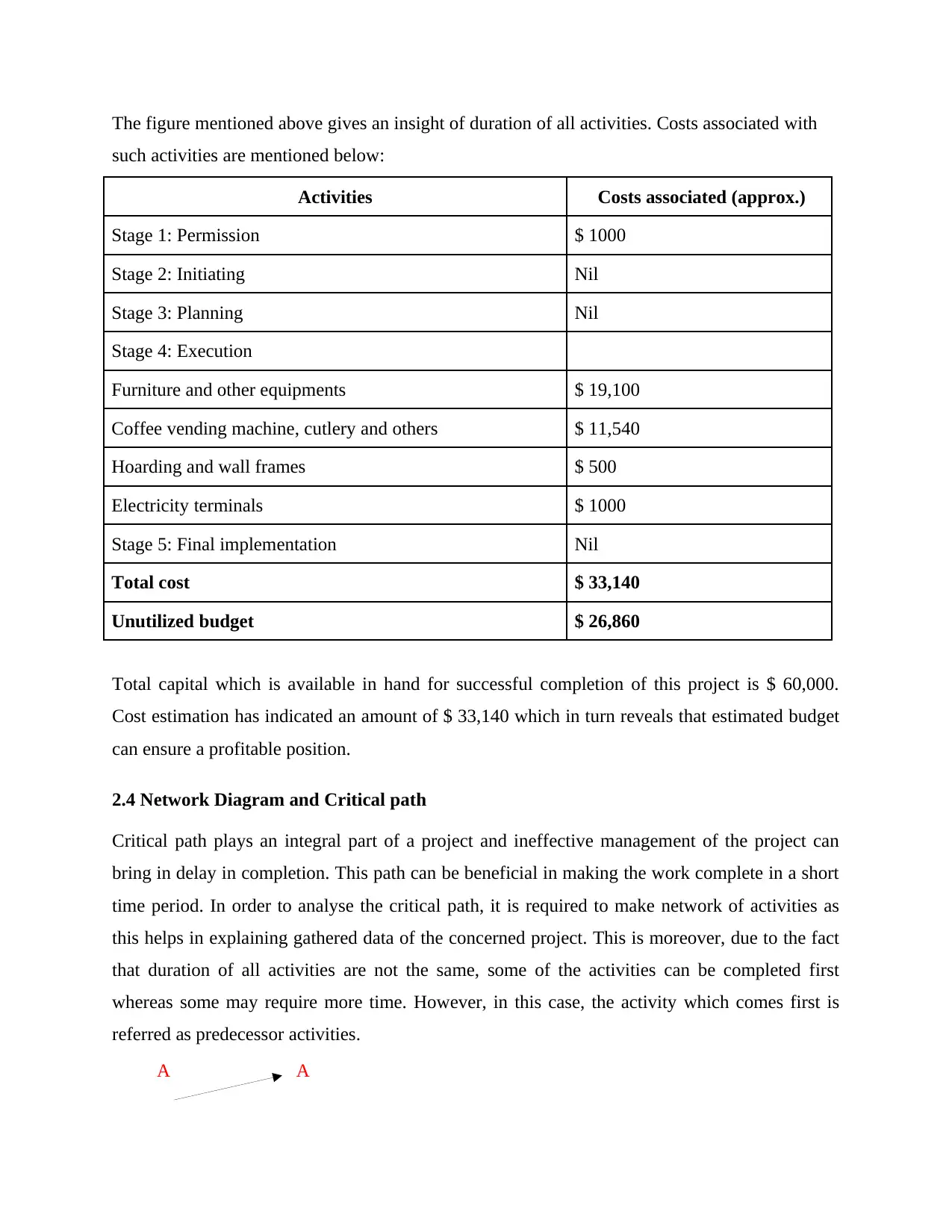
such activities are mentioned below:
Activities Costs associated (approx.)
Stage 1: Permission $ 1000
Stage 2: Initiating Nil
Stage 3: Planning Nil
Stage 4: Execution
Furniture and other equipments $ 19,100
Coffee vending machine, cutlery and others $ 11,540
Hoarding and wall frames $ 500
Electricity terminals $ 1000
Stage 5: Final implementation Nil
Total cost $ 33,140
Unutilized budget $ 26,860
Total capital which is available in hand for successful completion of this project is $ 60,000.
Cost estimation has indicated an amount of $ 33,140 which in turn reveals that estimated budget
can ensure a profitable position.
2.4 Network Diagram and Critical path
Critical path plays an integral part of a project and ineffective management of the project can
bring in delay in completion. This path can be beneficial in making the work complete in a short
time period. In order to analyse the critical path, it is required to make network of activities as
this helps in explaining gathered data of the concerned project. This is moreover, due to the fact
that duration of all activities are not the same, some of the activities can be completed first
whereas some may require more time. However, in this case, the activity which comes first is
referred as predecessor activities.
A A
Paraphrase This Document
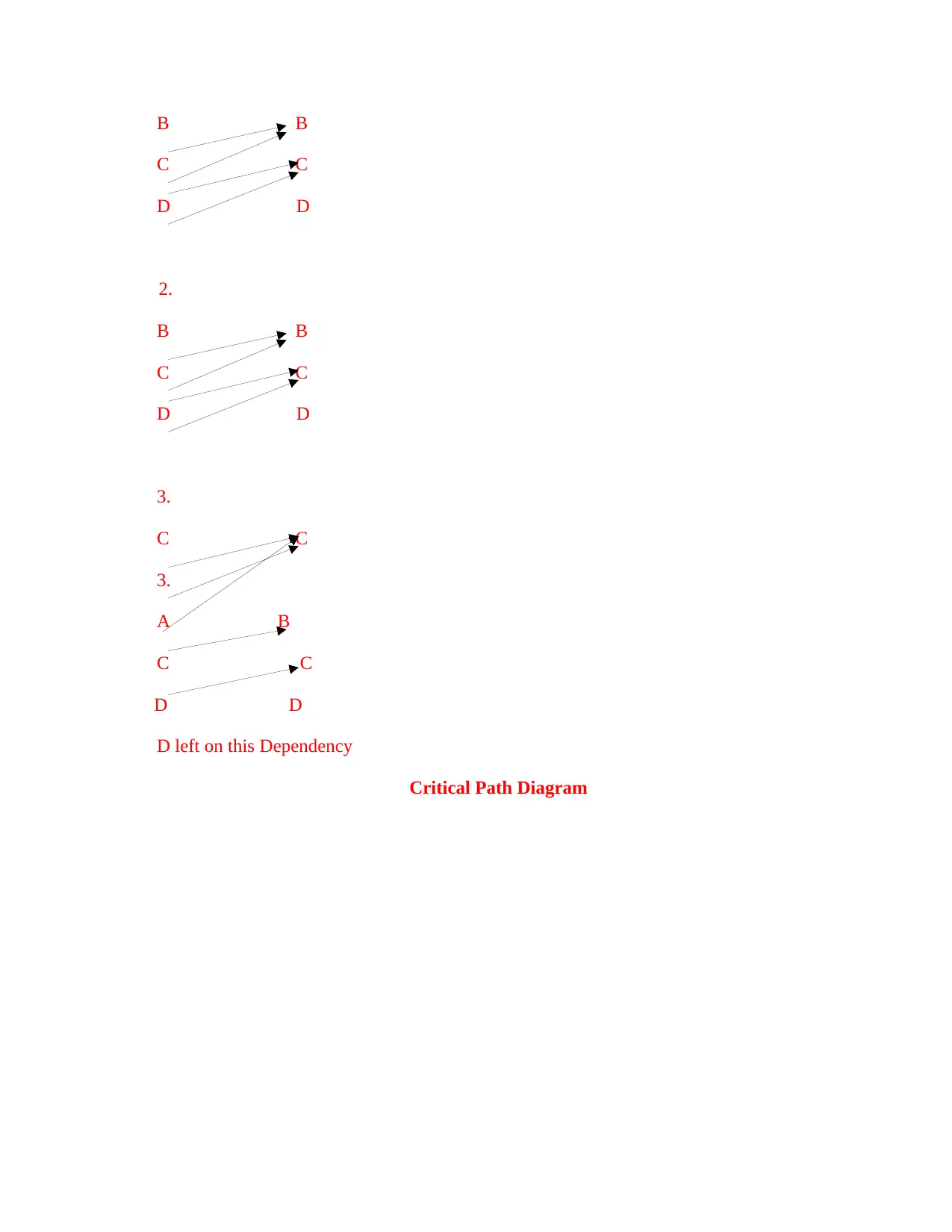
C C
D D
2.
B B
C C
D D
3.
C C
3.
A B
C C
D D
D left on this Dependency
Critical Path Diagram
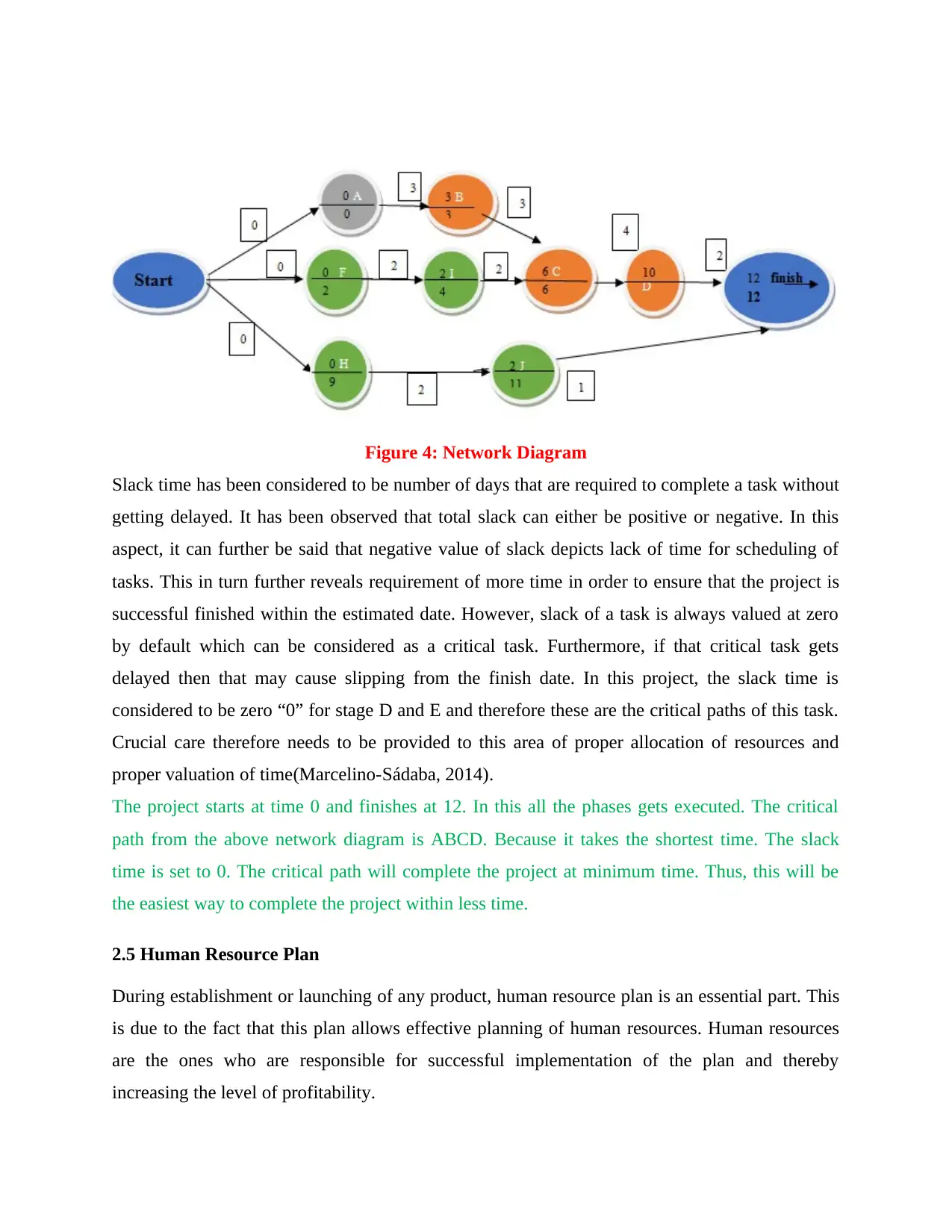
Slack time has been considered to be number of days that are required to complete a task without
getting delayed. It has been observed that total slack can either be positive or negative. In this
aspect, it can further be said that negative value of slack depicts lack of time for scheduling of
tasks. This in turn further reveals requirement of more time in order to ensure that the project is
successful finished within the estimated date. However, slack of a task is always valued at zero
by default which can be considered as a critical task. Furthermore, if that critical task gets
delayed then that may cause slipping from the finish date. In this project, the slack time is
considered to be zero “0” for stage D and E and therefore these are the critical paths of this task.
Crucial care therefore needs to be provided to this area of proper allocation of resources and
proper valuation of time(Marcelino-Sádaba, 2014).
The project starts at time 0 and finishes at 12. In this all the phases gets executed. The critical
path from the above network diagram is ABCD. Because it takes the shortest time. The slack
time is set to 0. The critical path will complete the project at minimum time. Thus, this will be
the easiest way to complete the project within less time.
2.5 Human Resource Plan
During establishment or launching of any product, human resource plan is an essential part. This
is due to the fact that this plan allows effective planning of human resources. Human resources
are the ones who are responsible for successful implementation of the plan and thereby
increasing the level of profitability.
⊘ This is a preview!⊘
Do you want full access?
Subscribe today to unlock all pages.

Trusted by 1+ million students worldwide
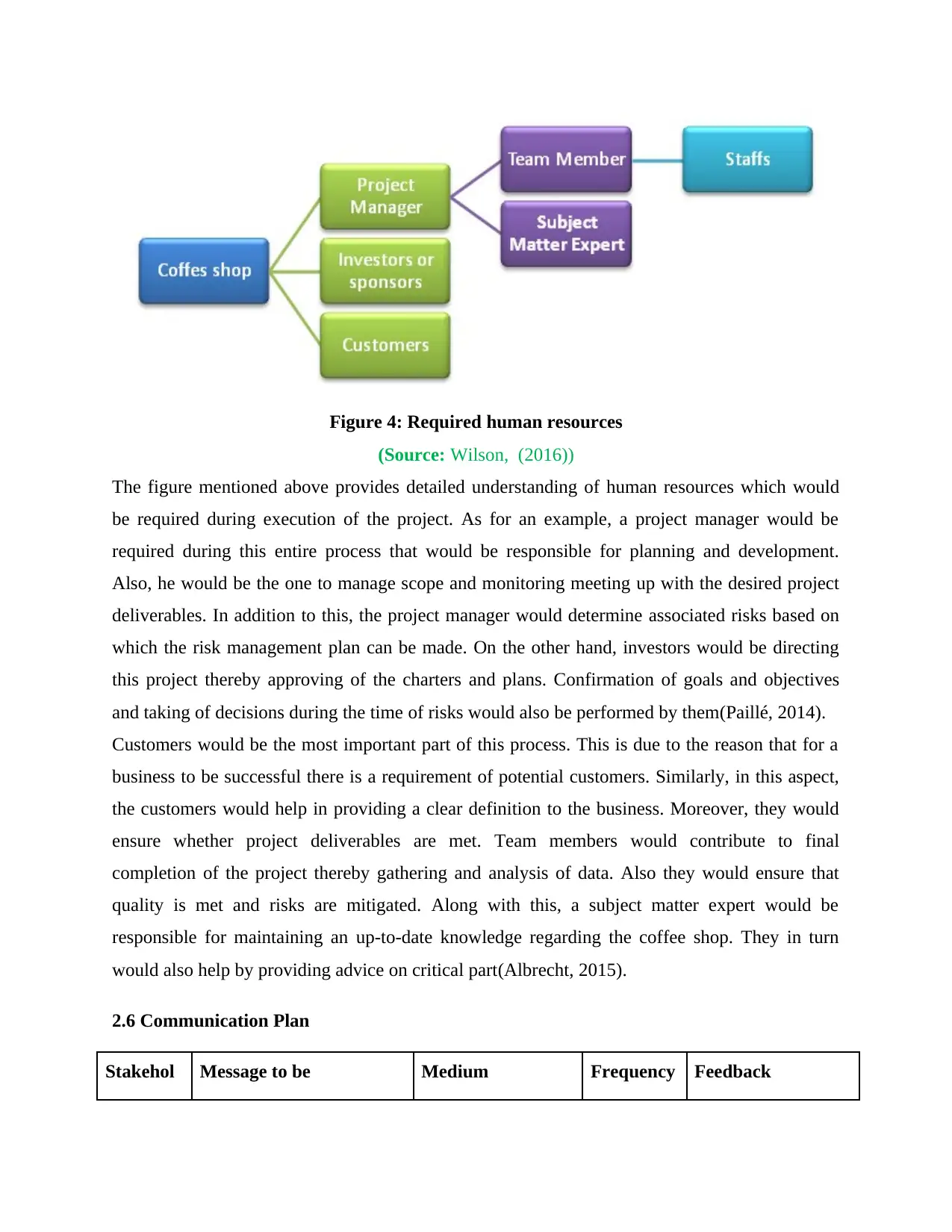
(Source: Wilson, (2016))
The figure mentioned above provides detailed understanding of human resources which would
be required during execution of the project. As for an example, a project manager would be
required during this entire process that would be responsible for planning and development.
Also, he would be the one to manage scope and monitoring meeting up with the desired project
deliverables. In addition to this, the project manager would determine associated risks based on
which the risk management plan can be made. On the other hand, investors would be directing
this project thereby approving of the charters and plans. Confirmation of goals and objectives
and taking of decisions during the time of risks would also be performed by them(Paillé, 2014).
Customers would be the most important part of this process. This is due to the reason that for a
business to be successful there is a requirement of potential customers. Similarly, in this aspect,
the customers would help in providing a clear definition to the business. Moreover, they would
ensure whether project deliverables are met. Team members would contribute to final
completion of the project thereby gathering and analysis of data. Also they would ensure that
quality is met and risks are mitigated. Along with this, a subject matter expert would be
responsible for maintaining an up-to-date knowledge regarding the coffee shop. They in turn
would also help by providing advice on critical part(Albrecht, 2015).
2.6 Communication Plan
Stakehol Message to be Medium Frequency Feedback
Paraphrase This Document
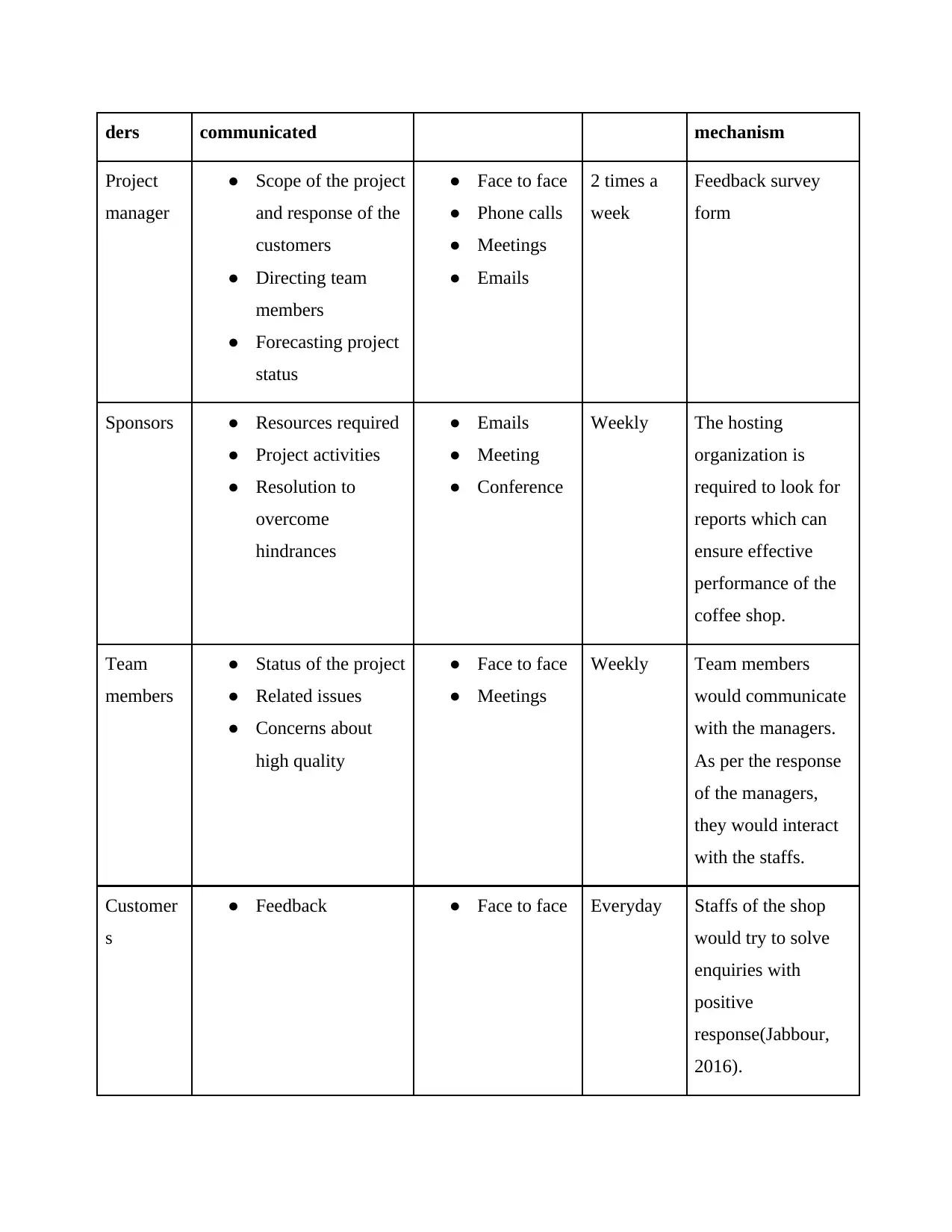
Project
manager
● Scope of the project
and response of the
customers
● Directing team
members
● Forecasting project
status
● Face to face
● Phone calls
● Meetings
● Emails
2 times a
week
Feedback survey
form
Sponsors ● Resources required
● Project activities
● Resolution to
overcome
hindrances
● Emails
● Meeting
● Conference
Weekly The hosting
organization is
required to look for
reports which can
ensure effective
performance of the
coffee shop.
Team
members
● Status of the project
● Related issues
● Concerns about
high quality
● Face to face
● Meetings
Weekly Team members
would communicate
with the managers.
As per the response
of the managers,
they would interact
with the staffs.
Customer
s
● Feedback ● Face to face Everyday Staffs of the shop
would try to solve
enquiries with
positive
response(Jabbour,
2016).
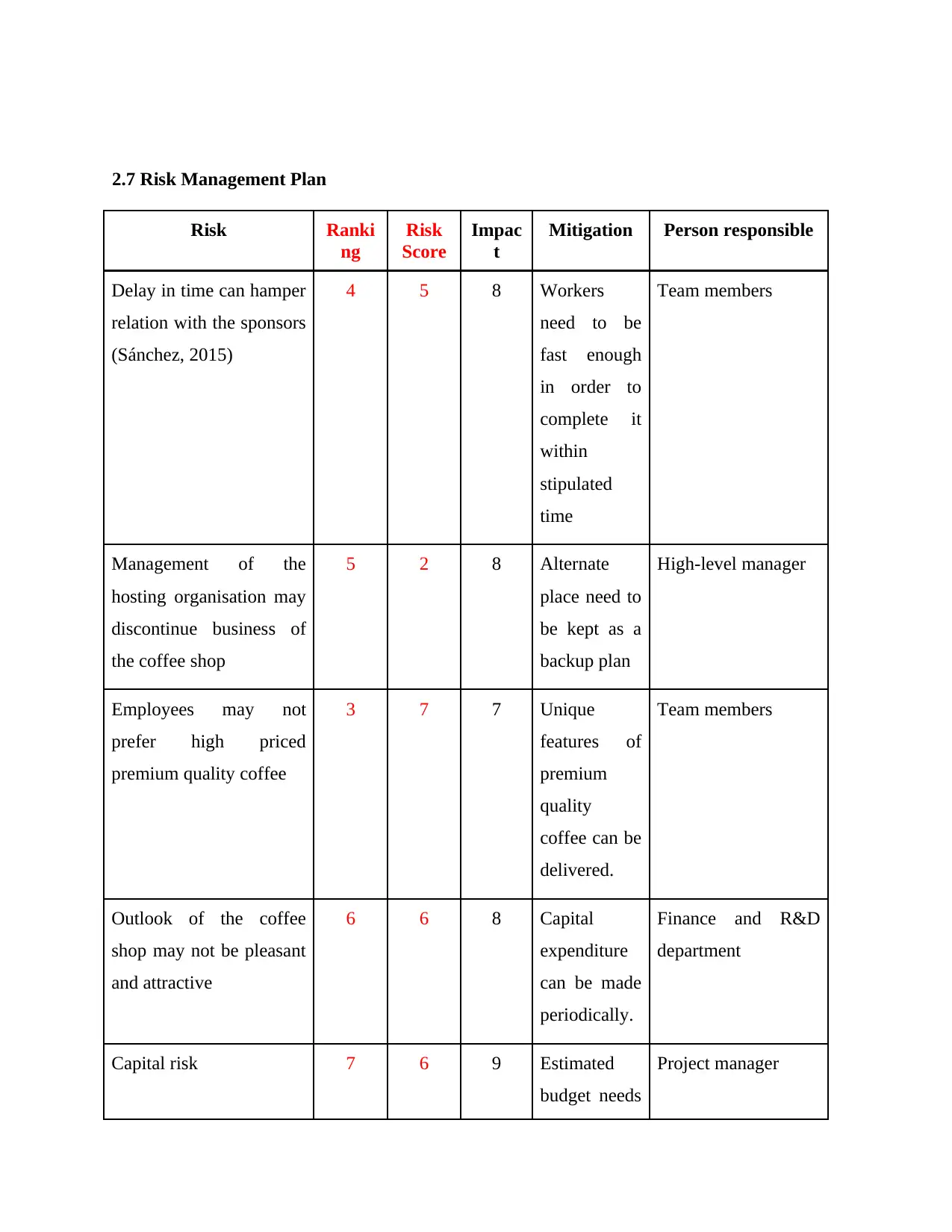
Risk Ranki
ng
Risk
Score
Impac
t
Mitigation Person responsible
Delay in time can hamper
relation with the sponsors
(Sánchez, 2015)
4 5 8 Workers
need to be
fast enough
in order to
complete it
within
stipulated
time
Team members
Management of the
hosting organisation may
discontinue business of
the coffee shop
5 2 8 Alternate
place need to
be kept as a
backup plan
High-level manager
Employees may not
prefer high priced
premium quality coffee
3 7 7 Unique
features of
premium
quality
coffee can be
delivered.
Team members
Outlook of the coffee
shop may not be pleasant
and attractive
6 6 8 Capital
expenditure
can be made
periodically.
Finance and R&D
department
Capital risk 7 6 9 Estimated
budget needs
Project manager
⊘ This is a preview!⊘
Do you want full access?
Subscribe today to unlock all pages.

Trusted by 1+ million students worldwide

mind before
planning.
Lack of skilled staffs and
employees
1 3 5 Training
need to be
provided on
a regular
basis
HR department
Accidents and injuries
due to natural as well as
artificial activities
2 4 8 The
infrastructure
must be such
that can
withstand
harsh
weather of
New
Zealand.
Safety
equipments
must be
installed(Bro
miley,
Enterprise
risk
management:
Review,
critique, and
research
directions,
2015).
Works department
Paraphrase This Document

highest. Risk has been ranked from 1 to 7.
The first risk is that if there are time delays then it can hamper the success of the company.
Again, there is a risk if the host organisation does not continue to do business in the coffee shop.
For this there needs to be an alternative plan. Moreover, if the price of coffee is high customers
might not prefer the company’s product.
Investments are to be made periodically in order to renovate the coffee shop or it might seem
unpleasant. The lack of skilled workers or expertise in the organisation is a big risk to the
company so it needs to be given prior importance. Again, the price of the product is to be kept
low in order to attract the customers or the high prices might deviate them to some other
company. Delay in time is also an important factor and needs to given prior importance.
2.8 Compliance requirement
There are several rules and regulations which need to be considered while opening or
establishing a new business. Similarly, while opening up a new coffee shop, it is required to
comply with the Building and construction regulation 2010, Contract Act 2002, along with the
Fire services Act 1975. Contract Act 2002 is responsible for maintaining a safe and secure
contract as often payment is related with this. Furthermore, as per this law, retention money can
be used only for commercial purpose. On the other hand, as per the basis of the building law,
role of an inspector is selected by State Secretary and Council. In addition to this, another
compliance that needs to be viewed in this case is health and safety regulations for staffs and
employees of the coffee shop. In this aspect, Fire Safety Act can be relevant for organisations.
Food safety
Food safety system of New Zealand has been derived from farm to fork. This includes all
products which are mainly used for consumption by either human being of pets and animals. As
per the New Zealand Food Safety Authority, it is mandatory to meet up with the standards of
food safety as this can help in saving individuals. Standards of food safety can be met with the
help of food operating practices (GOP) and Hazard analysis and Critical Control Point (HACCP)
system(Food safety codes and standards, 2018).
Emergency exit
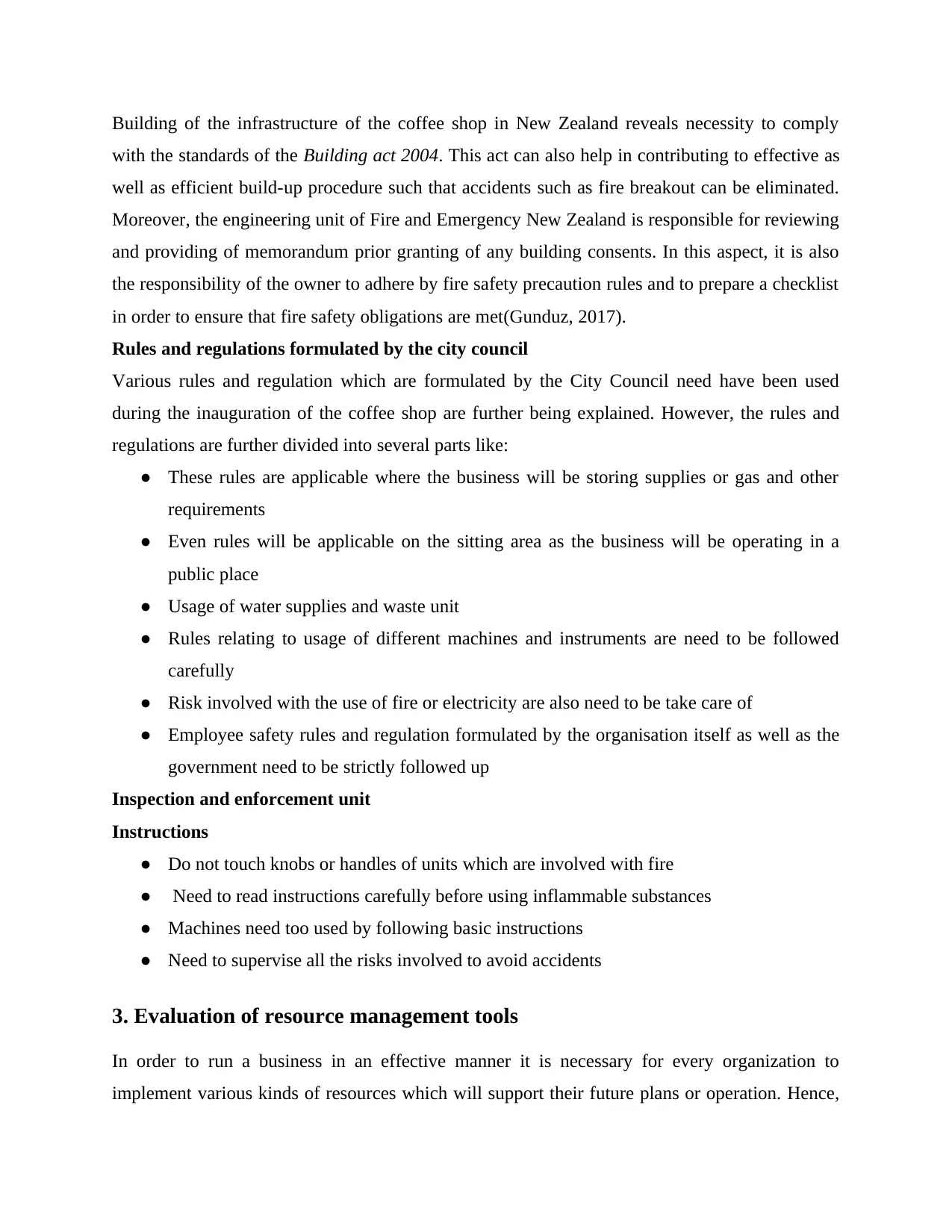
with the standards of the Building act 2004. This act can also help in contributing to effective as
well as efficient build-up procedure such that accidents such as fire breakout can be eliminated.
Moreover, the engineering unit of Fire and Emergency New Zealand is responsible for reviewing
and providing of memorandum prior granting of any building consents. In this aspect, it is also
the responsibility of the owner to adhere by fire safety precaution rules and to prepare a checklist
in order to ensure that fire safety obligations are met(Gunduz, 2017).
Rules and regulations formulated by the city council
Various rules and regulation which are formulated by the City Council need have been used
during the inauguration of the coffee shop are further being explained. However, the rules and
regulations are further divided into several parts like:
● These rules are applicable where the business will be storing supplies or gas and other
requirements
● Even rules will be applicable on the sitting area as the business will be operating in a
public place
● Usage of water supplies and waste unit
● Rules relating to usage of different machines and instruments are need to be followed
carefully
● Risk involved with the use of fire or electricity are also need to be take care of
● Employee safety rules and regulation formulated by the organisation itself as well as the
government need to be strictly followed up
Inspection and enforcement unit
Instructions
● Do not touch knobs or handles of units which are involved with fire
● Need to read instructions carefully before using inflammable substances
● Machines need too used by following basic instructions
● Need to supervise all the risks involved to avoid accidents
3. Evaluation of resource management tools
In order to run a business in an effective manner it is necessary for every organization to
implement various kinds of resources which will support their future plans or operation. Hence,
⊘ This is a preview!⊘
Do you want full access?
Subscribe today to unlock all pages.

Trusted by 1+ million students worldwide
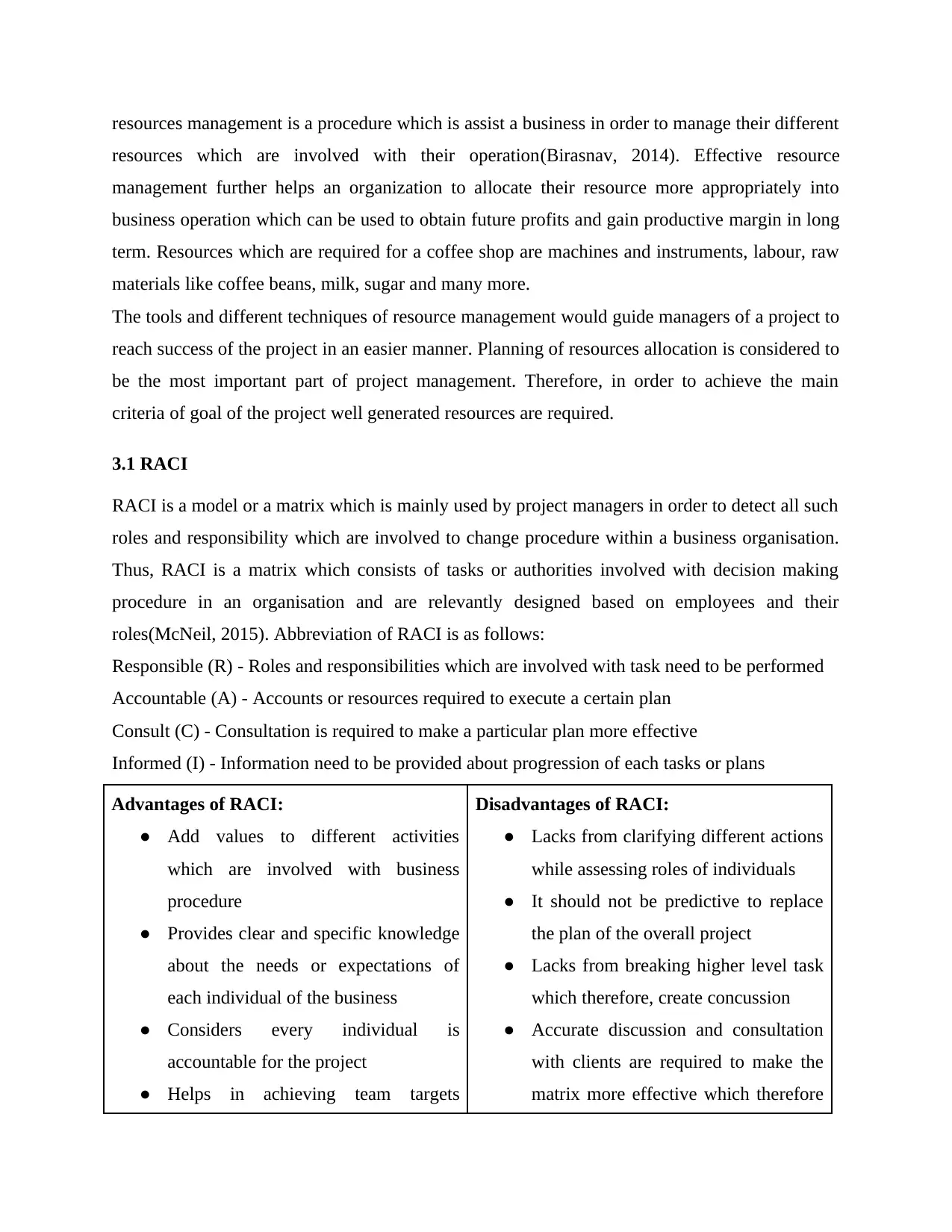
resources which are involved with their operation(Birasnav, 2014). Effective resource
management further helps an organization to allocate their resource more appropriately into
business operation which can be used to obtain future profits and gain productive margin in long
term. Resources which are required for a coffee shop are machines and instruments, labour, raw
materials like coffee beans, milk, sugar and many more.
The tools and different techniques of resource management would guide managers of a project to
reach success of the project in an easier manner. Planning of resources allocation is considered to
be the most important part of project management. Therefore, in order to achieve the main
criteria of goal of the project well generated resources are required.
3.1 RACI
RACI is a model or a matrix which is mainly used by project managers in order to detect all such
roles and responsibility which are involved to change procedure within a business organisation.
Thus, RACI is a matrix which consists of tasks or authorities involved with decision making
procedure in an organisation and are relevantly designed based on employees and their
roles(McNeil, 2015). Abbreviation of RACI is as follows:
Responsible (R) - Roles and responsibilities which are involved with task need to be performed
Accountable (A) - Accounts or resources required to execute a certain plan
Consult (C) - Consultation is required to make a particular plan more effective
Informed (I) - Information need to be provided about progression of each tasks or plans
Advantages of RACI:
● Add values to different activities
which are involved with business
procedure
● Provides clear and specific knowledge
about the needs or expectations of
each individual of the business
● Considers every individual is
accountable for the project
● Helps in achieving team targets
Disadvantages of RACI:
● Lacks from clarifying different actions
while assessing roles of individuals
● It should not be predictive to replace
the plan of the overall project
● Lacks from breaking higher level task
which therefore, create concussion
● Accurate discussion and consultation
with clients are required to make the
matrix more effective which therefore
Paraphrase This Document

● Defines the barriers among individuals
cause in delivery delays
3.2 ERP
Enterprise resource planning (ERP) is an industrial resources management tool which is being
utilised by business organisation to manage their operating activities. The most highlighted goals
of ERP software are combining business procedure from back office activities and provide an
integrated view in order to improve information collaboration among corporate as well as
functional boundaries(Bromiley, Enterprise risk management: Review, critique, and research
directions, 2015). Thus, ERP would further help the project managers to gather data and
effective information regarding business decisions.
Advantages of ERP:
● Utilises components of software in
order to forecast relevant data of the
business
● Generates effective plans relating to
communication among different units
in order to develop productivity into
the business
● Provides guidance on product
designing
● Mitigated customer barriers which
helps in meeting the basic requirement
● Collecting data based on invoices and
cash receipts makes it easier for
manager to track sales and revenues
within a specific time period
Disadvantages of ERP:
● Options to consumer access is limited
to a certain extent
● Installation cost of the software is
considered to be costly for small
business organisation
● Relocation of the software installed
found to be expensive for most of the
organisation
3.3 MRP
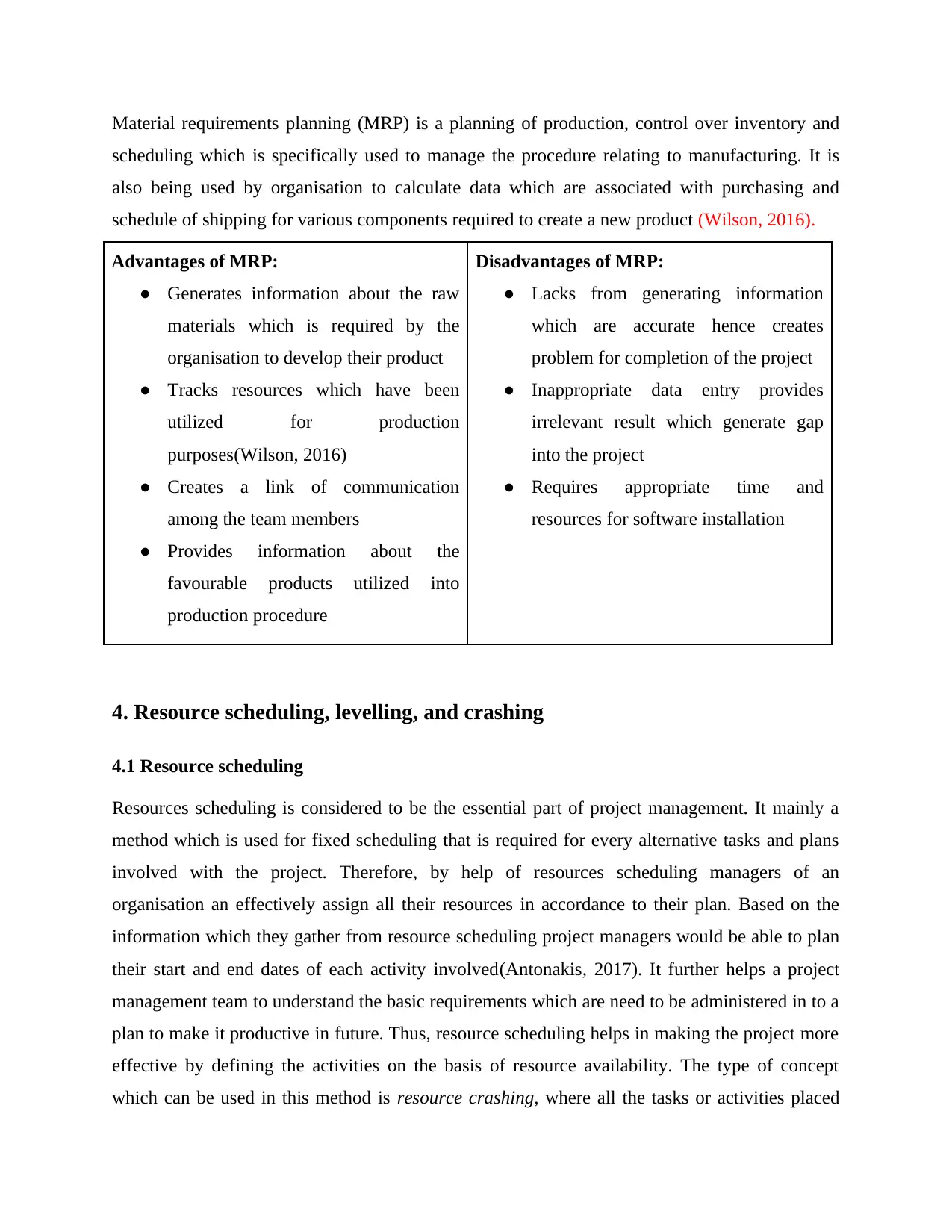
scheduling which is specifically used to manage the procedure relating to manufacturing. It is
also being used by organisation to calculate data which are associated with purchasing and
schedule of shipping for various components required to create a new product (Wilson, 2016).
Advantages of MRP:
● Generates information about the raw
materials which is required by the
organisation to develop their product
● Tracks resources which have been
utilized for production
purposes(Wilson, 2016)
● Creates a link of communication
among the team members
● Provides information about the
favourable products utilized into
production procedure
Disadvantages of MRP:
● Lacks from generating information
which are accurate hence creates
problem for completion of the project
● Inappropriate data entry provides
irrelevant result which generate gap
into the project
● Requires appropriate time and
resources for software installation
4. Resource scheduling, levelling, and crashing
4.1 Resource scheduling
Resources scheduling is considered to be the essential part of project management. It mainly a
method which is used for fixed scheduling that is required for every alternative tasks and plans
involved with the project. Therefore, by help of resources scheduling managers of an
organisation an effectively assign all their resources in accordance to their plan. Based on the
information which they gather from resource scheduling project managers would be able to plan
their start and end dates of each activity involved(Antonakis, 2017). It further helps a project
management team to understand the basic requirements which are need to be administered in to a
plan to make it productive in future. Thus, resource scheduling helps in making the project more
effective by defining the activities on the basis of resource availability. The type of concept
which can be used in this method is resource crashing, where all the tasks or activities placed
⊘ This is a preview!⊘
Do you want full access?
Subscribe today to unlock all pages.

Trusted by 1+ million students worldwide
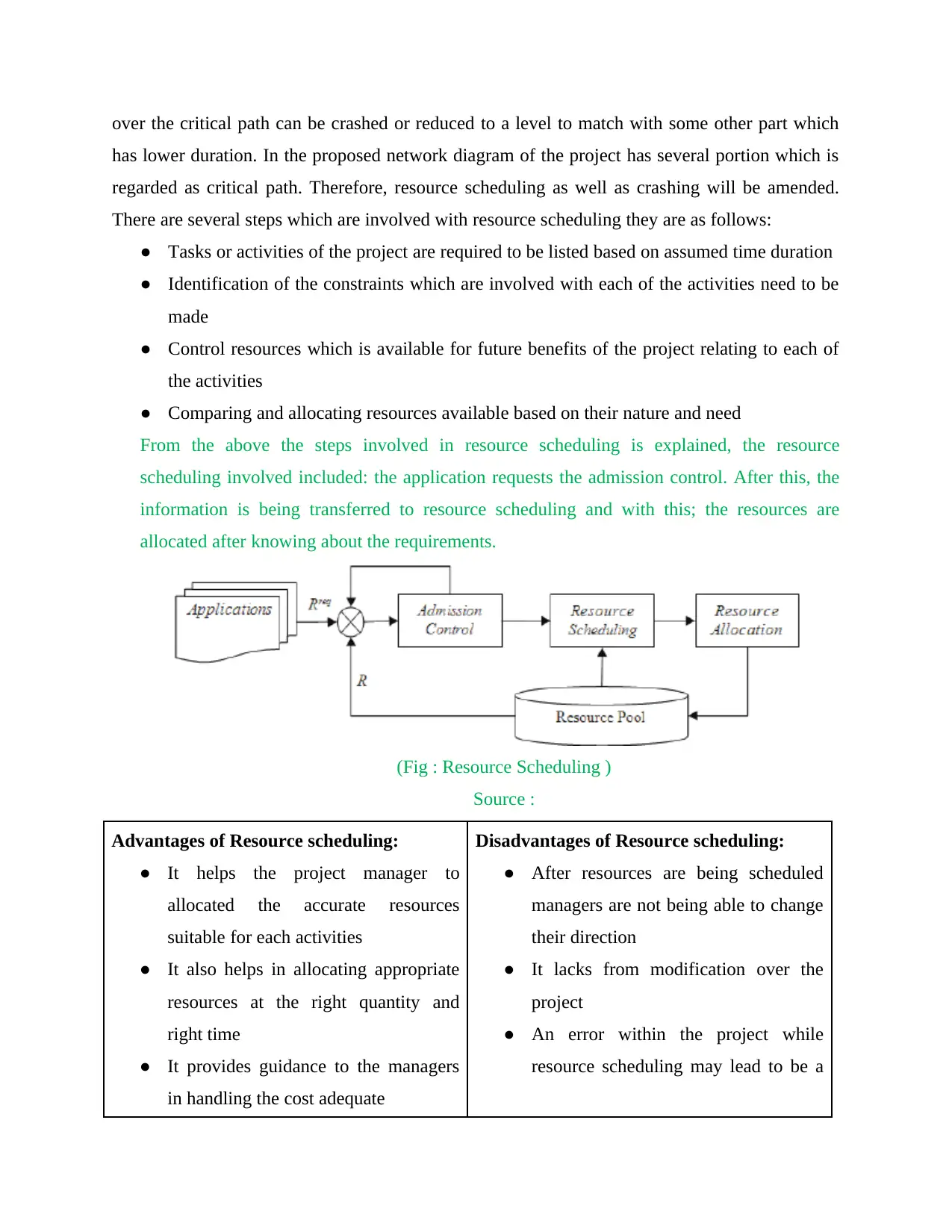
has lower duration. In the proposed network diagram of the project has several portion which is
regarded as critical path. Therefore, resource scheduling as well as crashing will be amended.
There are several steps which are involved with resource scheduling they are as follows:
● Tasks or activities of the project are required to be listed based on assumed time duration
● Identification of the constraints which are involved with each of the activities need to be
made
● Control resources which is available for future benefits of the project relating to each of
the activities
● Comparing and allocating resources available based on their nature and need
From the above the steps involved in resource scheduling is explained, the resource
scheduling involved included: the application requests the admission control. After this, the
information is being transferred to resource scheduling and with this; the resources are
allocated after knowing about the requirements.
(Fig : Resource Scheduling )
Source :
Advantages of Resource scheduling:
● It helps the project manager to
allocated the accurate resources
suitable for each activities
● It also helps in allocating appropriate
resources at the right quantity and
right time
● It provides guidance to the managers
in handling the cost adequate
Disadvantages of Resource scheduling:
● After resources are being scheduled
managers are not being able to change
their direction
● It lacks from modification over the
project
● An error within the project while
resource scheduling may lead to be a
Paraphrase This Document
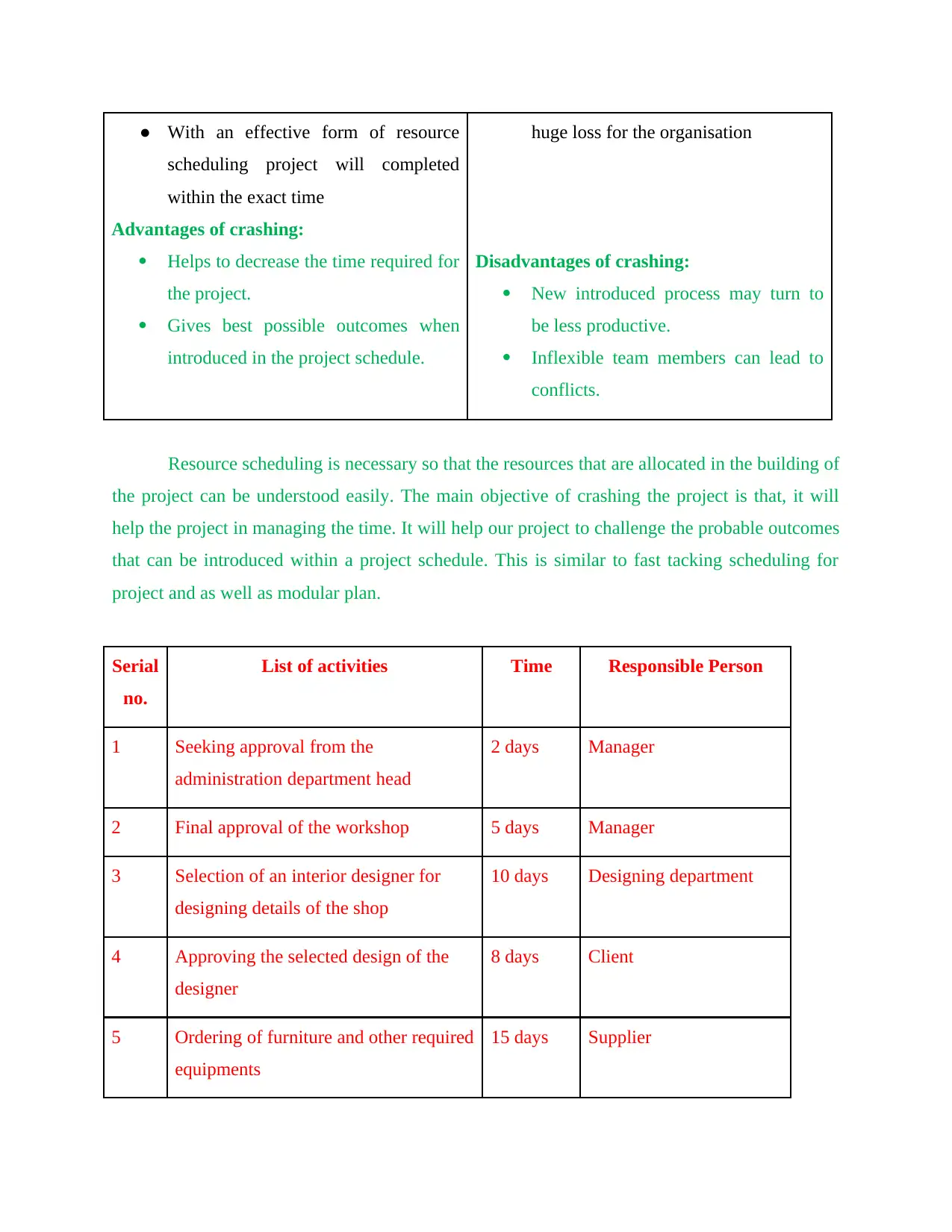
scheduling project will completed
within the exact time
Advantages of crashing:
Helps to decrease the time required for
the project.
Gives best possible outcomes when
introduced in the project schedule.
huge loss for the organisation
Disadvantages of crashing:
New introduced process may turn to
be less productive.
Inflexible team members can lead to
conflicts.
Resource scheduling is necessary so that the resources that are allocated in the building of
the project can be understood easily. The main objective of crashing the project is that, it will
help the project in managing the time. It will help our project to challenge the probable outcomes
that can be introduced within a project schedule. This is similar to fast tacking scheduling for
project and as well as modular plan.
Serial
no.
List of activities Time Responsible Person
1 Seeking approval from the
administration department head
2 days Manager
2 Final approval of the workshop 5 days Manager
3 Selection of an interior designer for
designing details of the shop
10 days Designing department
4 Approving the selected design of the
designer
8 days Client
5 Ordering of furniture and other required
equipments
15 days Supplier
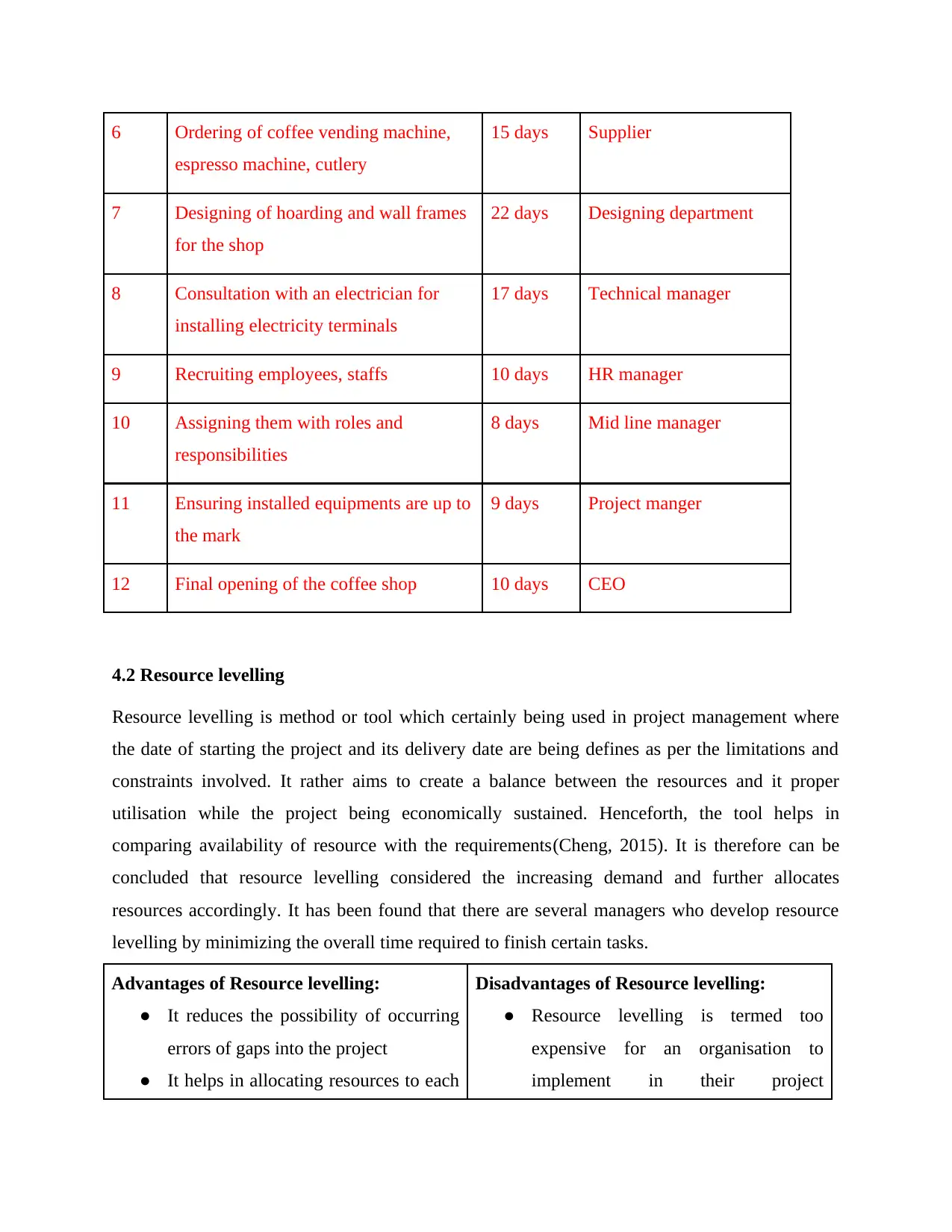
espresso machine, cutlery
15 days Supplier
7 Designing of hoarding and wall frames
for the shop
22 days Designing department
8 Consultation with an electrician for
installing electricity terminals
17 days Technical manager
9 Recruiting employees, staffs 10 days HR manager
10 Assigning them with roles and
responsibilities
8 days Mid line manager
11 Ensuring installed equipments are up to
the mark
9 days Project manger
12 Final opening of the coffee shop 10 days CEO
4.2 Resource levelling
Resource levelling is method or tool which certainly being used in project management where
the date of starting the project and its delivery date are being defines as per the limitations and
constraints involved. It rather aims to create a balance between the resources and it proper
utilisation while the project being economically sustained. Henceforth, the tool helps in
comparing availability of resource with the requirements(Cheng, 2015). It is therefore can be
concluded that resource levelling considered the increasing demand and further allocates
resources accordingly. It has been found that there are several managers who develop resource
levelling by minimizing the overall time required to finish certain tasks.
Advantages of Resource levelling:
● It reduces the possibility of occurring
errors of gaps into the project
● It helps in allocating resources to each
Disadvantages of Resource levelling:
● Resource levelling is termed too
expensive for an organisation to
implement in their project
⊘ This is a preview!⊘
Do you want full access?
Subscribe today to unlock all pages.

Trusted by 1+ million students worldwide
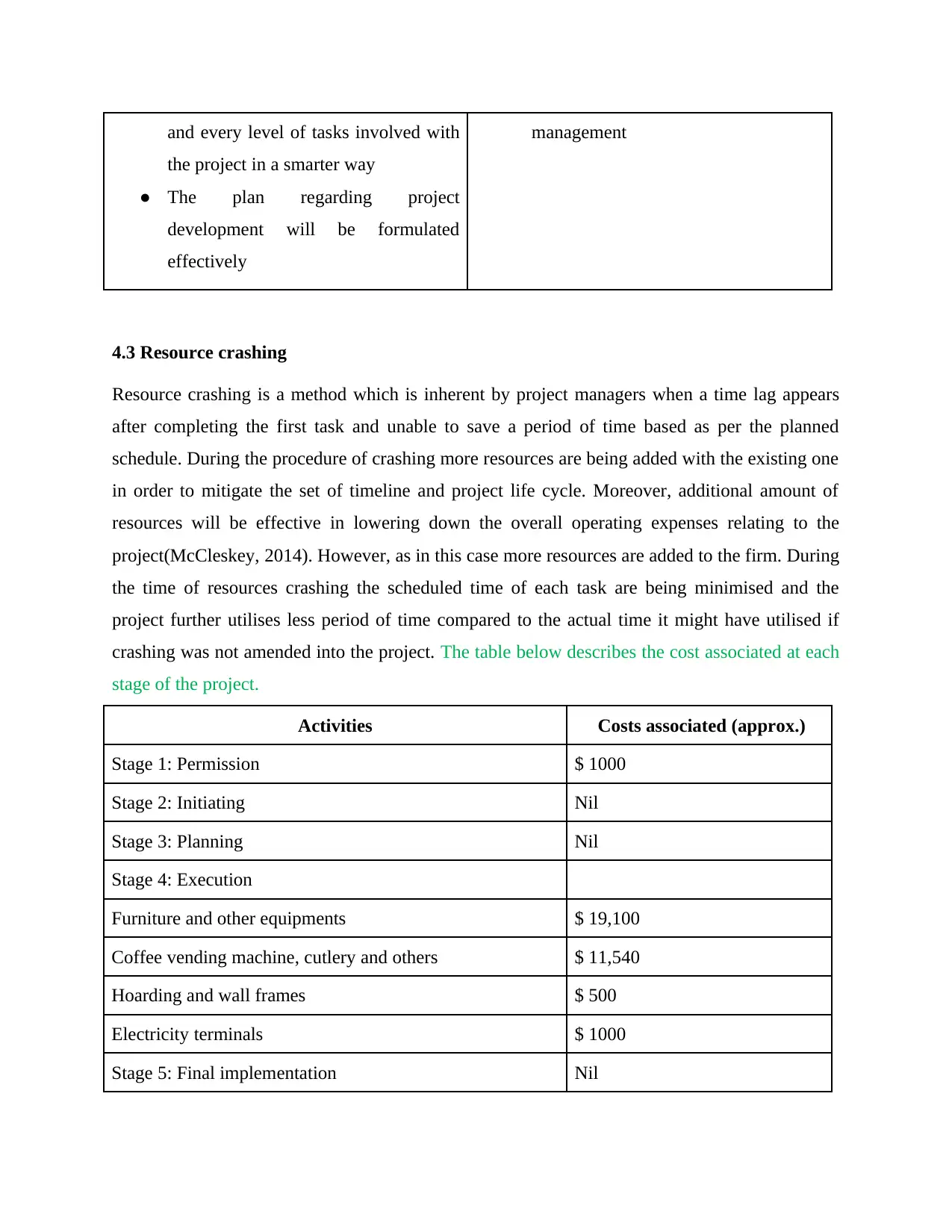
the project in a smarter way
● The plan regarding project
development will be formulated
effectively
management
4.3 Resource crashing
Resource crashing is a method which is inherent by project managers when a time lag appears
after completing the first task and unable to save a period of time based as per the planned
schedule. During the procedure of crashing more resources are being added with the existing one
in order to mitigate the set of timeline and project life cycle. Moreover, additional amount of
resources will be effective in lowering down the overall operating expenses relating to the
project(McCleskey, 2014). However, as in this case more resources are added to the firm. During
the time of resources crashing the scheduled time of each task are being minimised and the
project further utilises less period of time compared to the actual time it might have utilised if
crashing was not amended into the project. The table below describes the cost associated at each
stage of the project.
Activities Costs associated (approx.)
Stage 1: Permission $ 1000
Stage 2: Initiating Nil
Stage 3: Planning Nil
Stage 4: Execution
Furniture and other equipments $ 19,100
Coffee vending machine, cutlery and others $ 11,540
Hoarding and wall frames $ 500
Electricity terminals $ 1000
Stage 5: Final implementation Nil
Paraphrase This Document
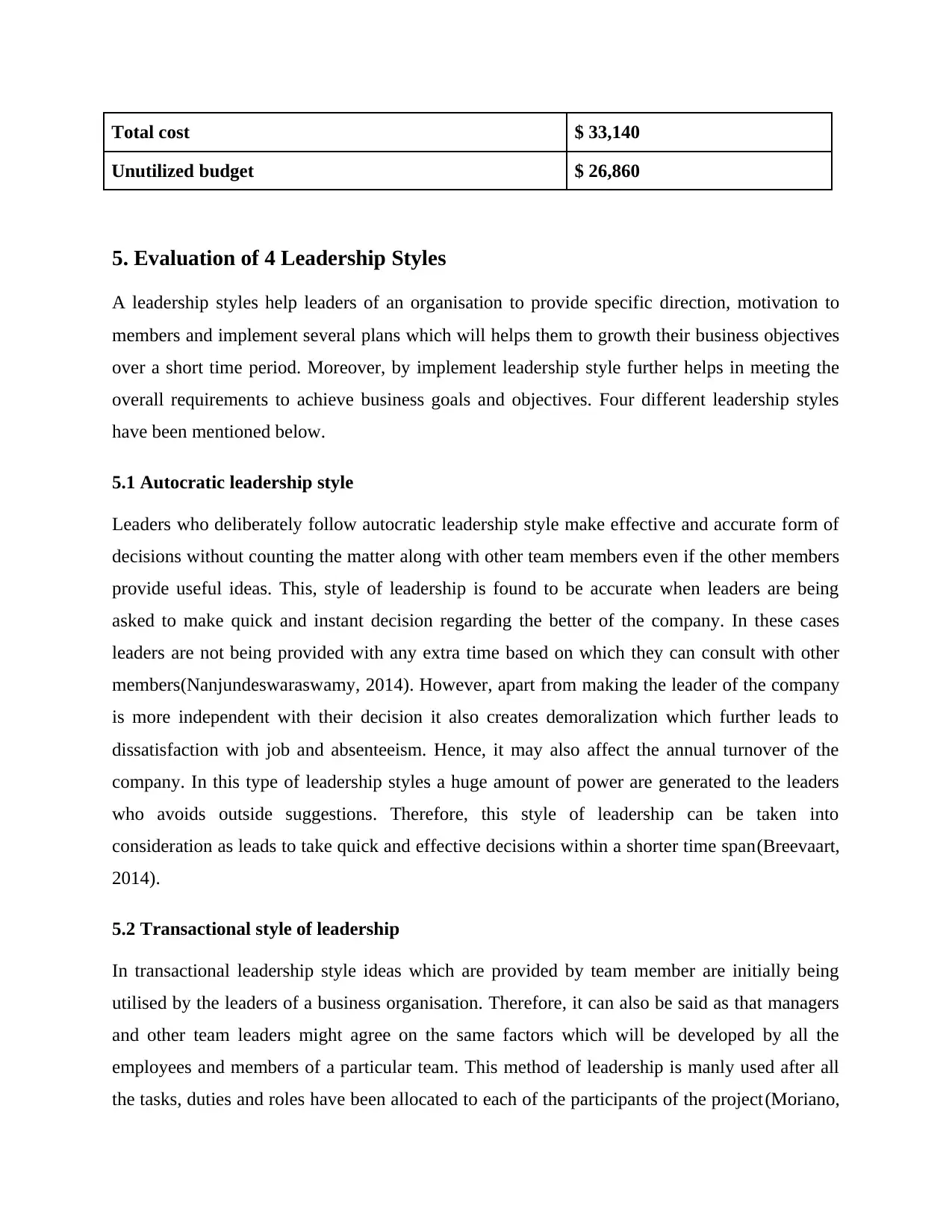
Unutilized budget $ 26,860
5. Evaluation of 4 Leadership Styles
A leadership styles help leaders of an organisation to provide specific direction, motivation to
members and implement several plans which will helps them to growth their business objectives
over a short time period. Moreover, by implement leadership style further helps in meeting the
overall requirements to achieve business goals and objectives. Four different leadership styles
have been mentioned below.
5.1 Autocratic leadership style
Leaders who deliberately follow autocratic leadership style make effective and accurate form of
decisions without counting the matter along with other team members even if the other members
provide useful ideas. This, style of leadership is found to be accurate when leaders are being
asked to make quick and instant decision regarding the better of the company. In these cases
leaders are not being provided with any extra time based on which they can consult with other
members(Nanjundeswaraswamy, 2014). However, apart from making the leader of the company
is more independent with their decision it also creates demoralization which further leads to
dissatisfaction with job and absenteeism. Hence, it may also affect the annual turnover of the
company. In this type of leadership styles a huge amount of power are generated to the leaders
who avoids outside suggestions. Therefore, this style of leadership can be taken into
consideration as leads to take quick and effective decisions within a shorter time span(Breevaart,
2014).
5.2 Transactional style of leadership
In transactional leadership style ideas which are provided by team member are initially being
utilised by the leaders of a business organisation. Therefore, it can also be said as that managers
and other team leaders might agree on the same factors which will be developed by all the
employees and members of a particular team. This method of leadership is manly used after all
the tasks, duties and roles have been allocated to each of the participants of the project (Moriano,
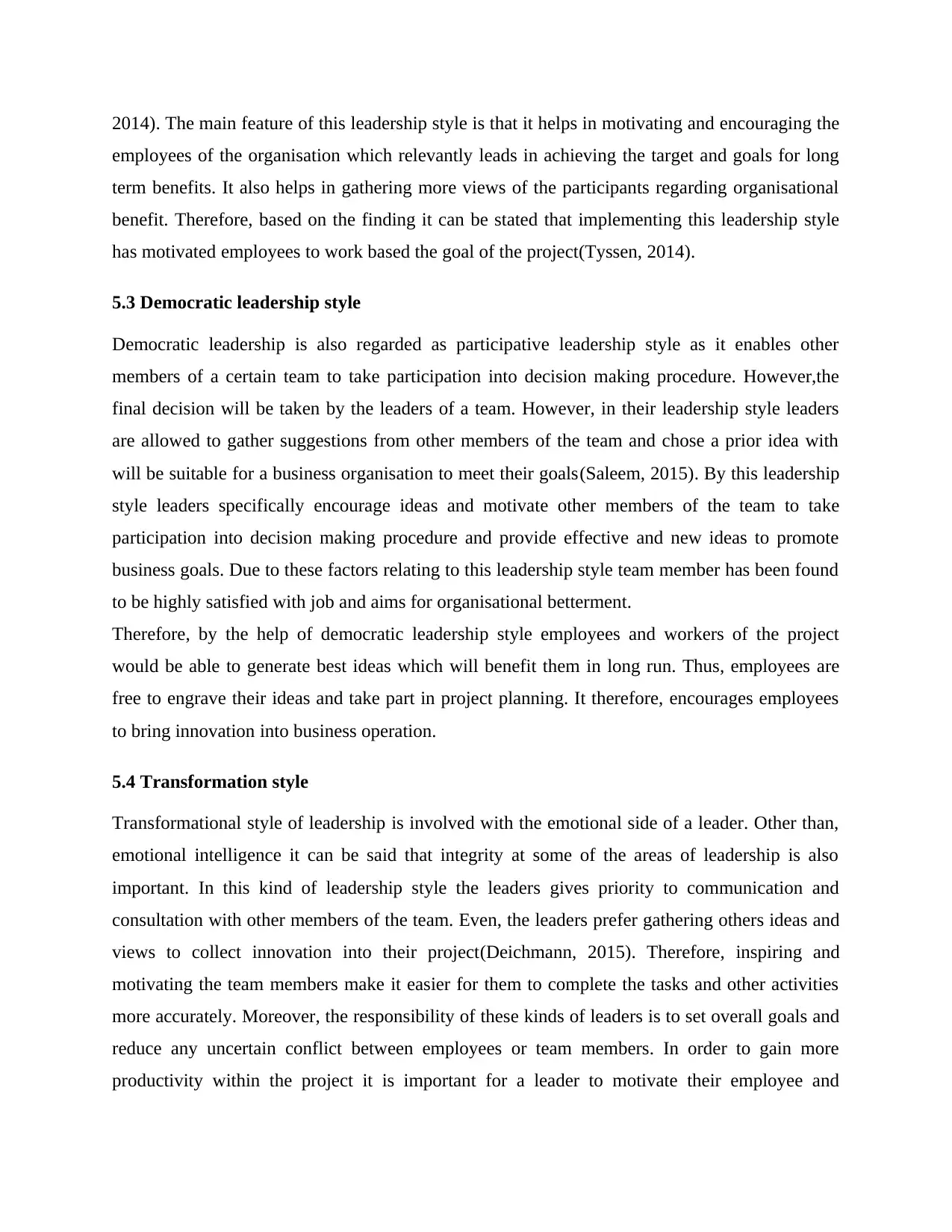
employees of the organisation which relevantly leads in achieving the target and goals for long
term benefits. It also helps in gathering more views of the participants regarding organisational
benefit. Therefore, based on the finding it can be stated that implementing this leadership style
has motivated employees to work based the goal of the project(Tyssen, 2014).
5.3 Democratic leadership style
Democratic leadership is also regarded as participative leadership style as it enables other
members of a certain team to take participation into decision making procedure. However,the
final decision will be taken by the leaders of a team. However, in their leadership style leaders
are allowed to gather suggestions from other members of the team and chose a prior idea with
will be suitable for a business organisation to meet their goals(Saleem, 2015). By this leadership
style leaders specifically encourage ideas and motivate other members of the team to take
participation into decision making procedure and provide effective and new ideas to promote
business goals. Due to these factors relating to this leadership style team member has been found
to be highly satisfied with job and aims for organisational betterment.
Therefore, by the help of democratic leadership style employees and workers of the project
would be able to generate best ideas which will benefit them in long run. Thus, employees are
free to engrave their ideas and take part in project planning. It therefore, encourages employees
to bring innovation into business operation.
5.4 Transformation style
Transformational style of leadership is involved with the emotional side of a leader. Other than,
emotional intelligence it can be said that integrity at some of the areas of leadership is also
important. In this kind of leadership style the leaders gives priority to communication and
consultation with other members of the team. Even, the leaders prefer gathering others ideas and
views to collect innovation into their project(Deichmann, 2015). Therefore, inspiring and
motivating the team members make it easier for them to complete the tasks and other activities
more accurately. Moreover, the responsibility of these kinds of leaders is to set overall goals and
reduce any uncertain conflict between employees or team members. In order to gain more
productivity within the project it is important for a leader to motivate their employee and
⊘ This is a preview!⊘
Do you want full access?
Subscribe today to unlock all pages.

Trusted by 1+ million students worldwide
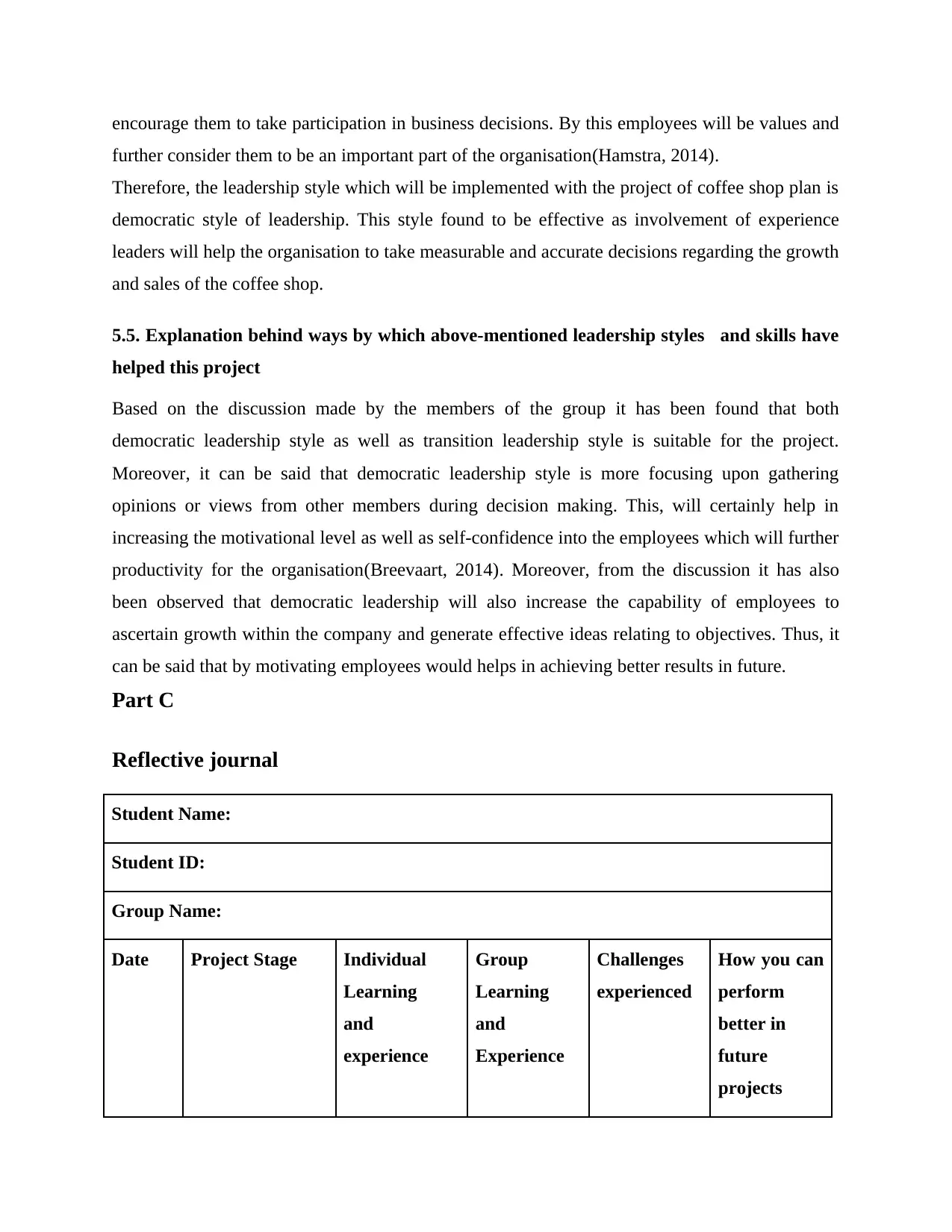
further consider them to be an important part of the organisation(Hamstra, 2014).
Therefore, the leadership style which will be implemented with the project of coffee shop plan is
democratic style of leadership. This style found to be effective as involvement of experience
leaders will help the organisation to take measurable and accurate decisions regarding the growth
and sales of the coffee shop.
5.5. Explanation behind ways by which above-mentioned leadership styles and skills have
helped this project
Based on the discussion made by the members of the group it has been found that both
democratic leadership style as well as transition leadership style is suitable for the project.
Moreover, it can be said that democratic leadership style is more focusing upon gathering
opinions or views from other members during decision making. This, will certainly help in
increasing the motivational level as well as self-confidence into the employees which will further
productivity for the organisation(Breevaart, 2014). Moreover, from the discussion it has also
been observed that democratic leadership will also increase the capability of employees to
ascertain growth within the company and generate effective ideas relating to objectives. Thus, it
can be said that by motivating employees would helps in achieving better results in future.
Part C
Reflective journal
Student Name:
Student ID:
Group Name:
Date Project Stage Individual
Learning
and
experience
Group
Learning
and
Experience
Challenges
experienced
How you can
perform
better in
future
projects
Paraphrase This Document

about all the
rules and
regulation
which are
involved while
opening a
business. It has
also increased
my knowledge
relating the
basic
requirements
which are need
to be followed
up by an
organisation to
start up a new
project.
I have learned
about how to
work together
and develop a
unity among
the team
members in
order to
gather
knowledge
and support
for
completing
task on time.
There were
many people
involved with
the project
who had
minimum
knowledge
regarding
laws and
regulations.
I will try to
increase my
knowledge
regarding
rules and
regulation in
order to avoid
any gap.
3.4.19 Initiating I have come to
gather
effective
knowledge
about project
initiation and
scope.
I have gained
idea about
how to merge
up with my
team and
work hand in
hand to
achieve our
targets on
time.
The challenge
which I have
faced while
initiating the
plan is that
we lacked
from any
experience
person who
can guide us
during project
By initiating
the project I
have gathered
idea on how
to manage
several
activities at a
particular
time period
and achieve
goals more
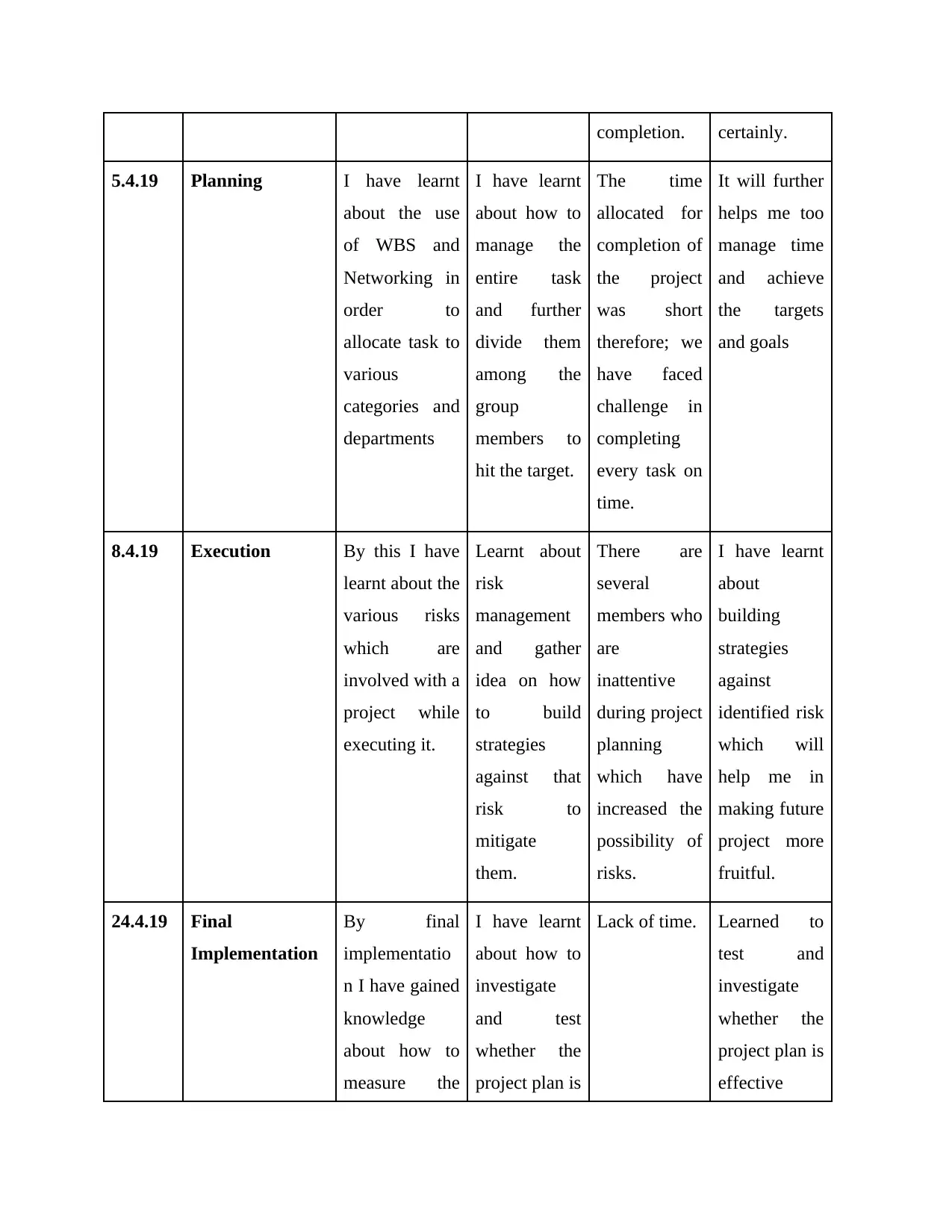
5.4.19 Planning I have learnt
about the use
of WBS and
Networking in
order to
allocate task to
various
categories and
departments
I have learnt
about how to
manage the
entire task
and further
divide them
among the
group
members to
hit the target.
The time
allocated for
completion of
the project
was short
therefore; we
have faced
challenge in
completing
every task on
time.
It will further
helps me too
manage time
and achieve
the targets
and goals
8.4.19 Execution By this I have
learnt about the
various risks
which are
involved with a
project while
executing it.
Learnt about
risk
management
and gather
idea on how
to build
strategies
against that
risk to
mitigate
them.
There are
several
members who
are
inattentive
during project
planning
which have
increased the
possibility of
risks.
I have learnt
about
building
strategies
against
identified risk
which will
help me in
making future
project more
fruitful.
24.4.19 Final
Implementation
By final
implementatio
n I have gained
knowledge
about how to
measure the
I have learnt
about how to
investigate
and test
whether the
project plan is
Lack of time. Learned to
test and
investigate
whether the
project plan is
effective
⊘ This is a preview!⊘
Do you want full access?
Subscribe today to unlock all pages.

Trusted by 1+ million students worldwide
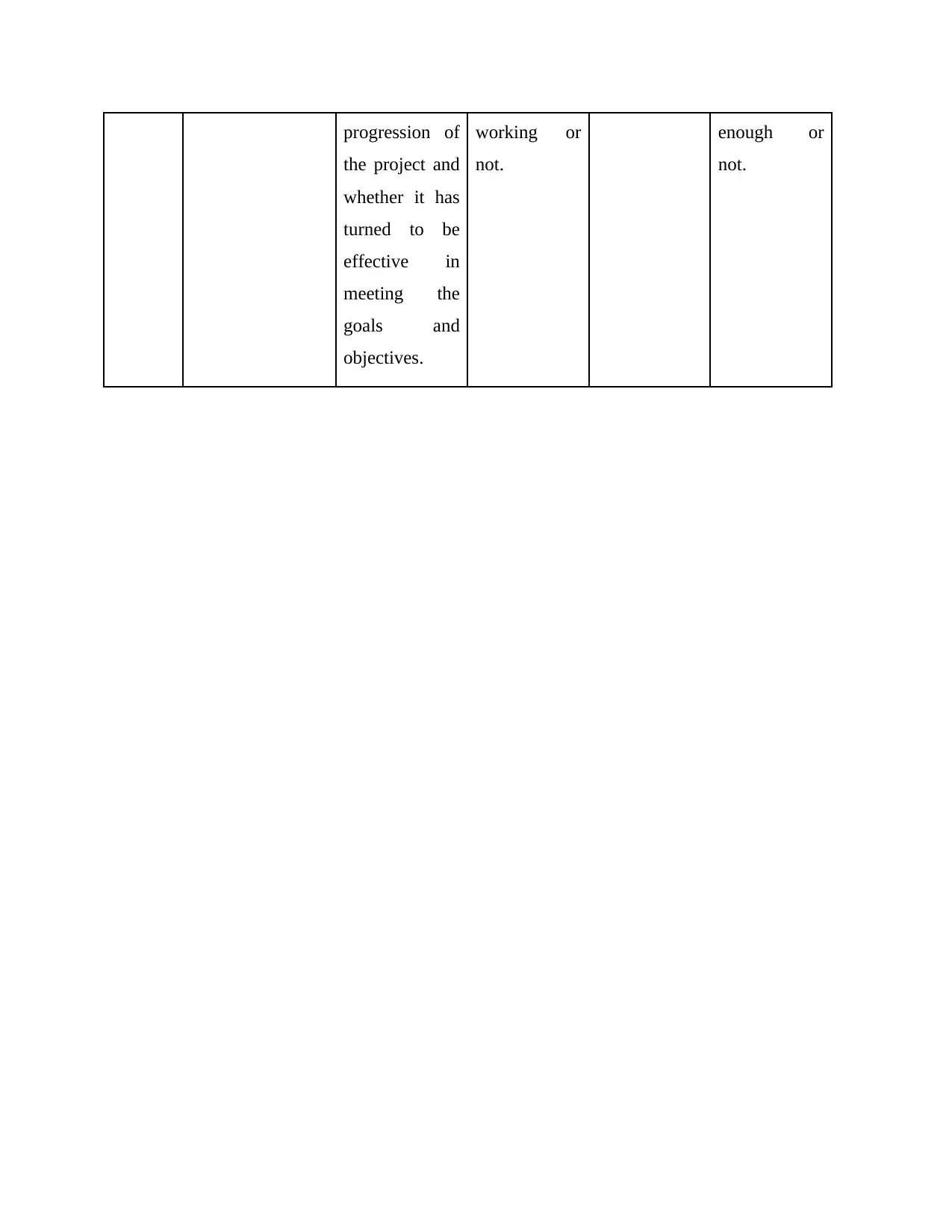
the project and
whether it has
turned to be
effective in
meeting the
goals and
objectives.
working or
not.
enough or
not.
Paraphrase This Document
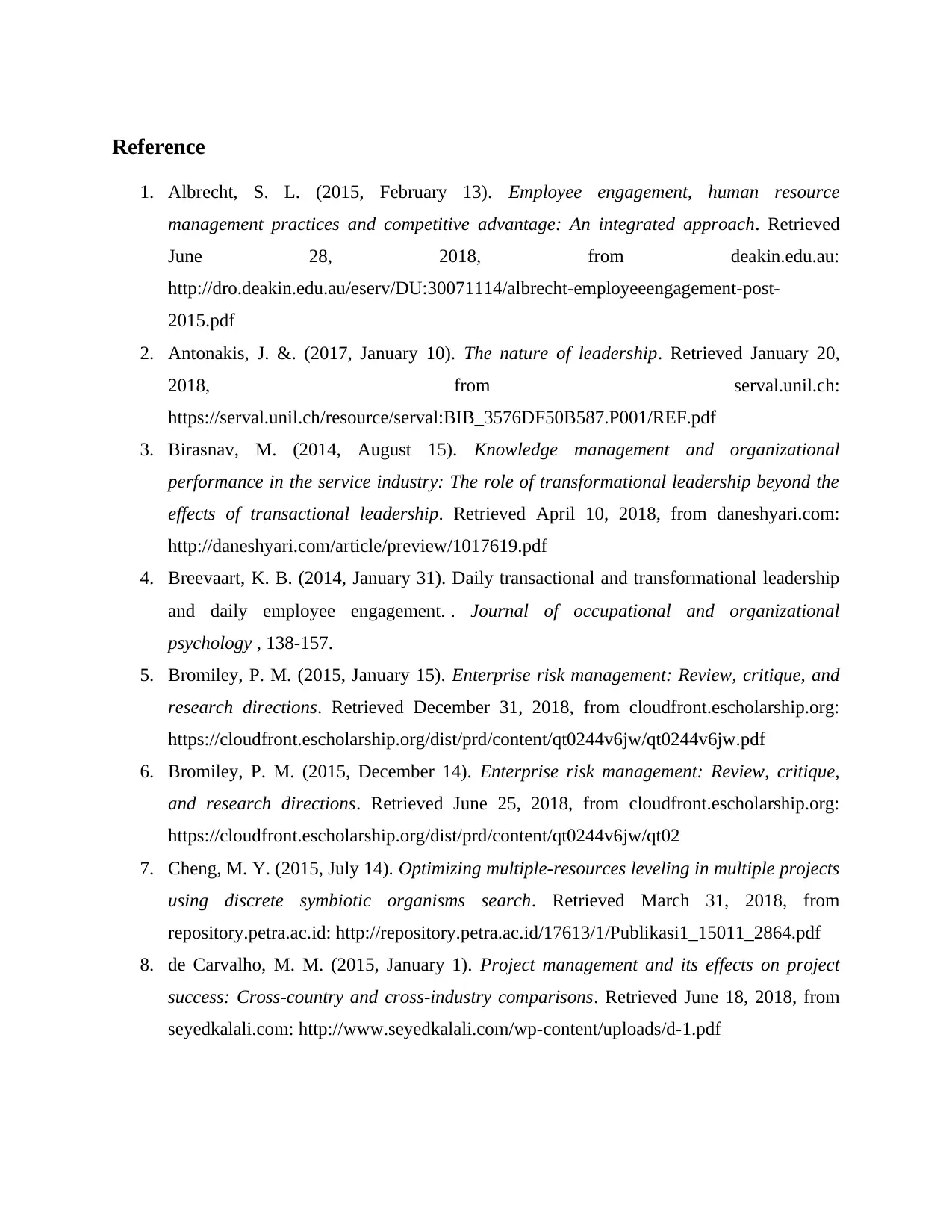
1. Albrecht, S. L. (2015, February 13). Employee engagement, human resource
management practices and competitive advantage: An integrated approach. Retrieved
June 28, 2018, from deakin.edu.au:
http://dro.deakin.edu.au/eserv/DU:30071114/albrecht-employeeengagement-post-
2015.pdf
2. Antonakis, J. &. (2017, January 10). The nature of leadership. Retrieved January 20,
2018, from serval.unil.ch:
https://serval.unil.ch/resource/serval:BIB_3576DF50B587.P001/REF.pdf
3. Birasnav, M. (2014, August 15). Knowledge management and organizational
performance in the service industry: The role of transformational leadership beyond the
effects of transactional leadership. Retrieved April 10, 2018, from daneshyari.com:
http://daneshyari.com/article/preview/1017619.pdf
4. Breevaart, K. B. (2014, January 31). Daily transactional and transformational leadership
and daily employee engagement. . Journal of occupational and organizational
psychology , 138-157.
5. Bromiley, P. M. (2015, January 15). Enterprise risk management: Review, critique, and
research directions. Retrieved December 31, 2018, from cloudfront.escholarship.org:
https://cloudfront.escholarship.org/dist/prd/content/qt0244v6jw/qt0244v6jw.pdf
6. Bromiley, P. M. (2015, December 14). Enterprise risk management: Review, critique,
and research directions. Retrieved June 25, 2018, from cloudfront.escholarship.org:
https://cloudfront.escholarship.org/dist/prd/content/qt0244v6jw/qt02
7. Cheng, M. Y. (2015, July 14). Optimizing multiple-resources leveling in multiple projects
using discrete symbiotic organisms search. Retrieved March 31, 2018, from
repository.petra.ac.id: http://repository.petra.ac.id/17613/1/Publikasi1_15011_2864.pdf
8. de Carvalho, M. M. (2015, January 1). Project management and its effects on project
success: Cross-country and cross-industry comparisons. Retrieved June 18, 2018, from
seyedkalali.com: http://www.seyedkalali.com/wp-content/uploads/d-1.pdf
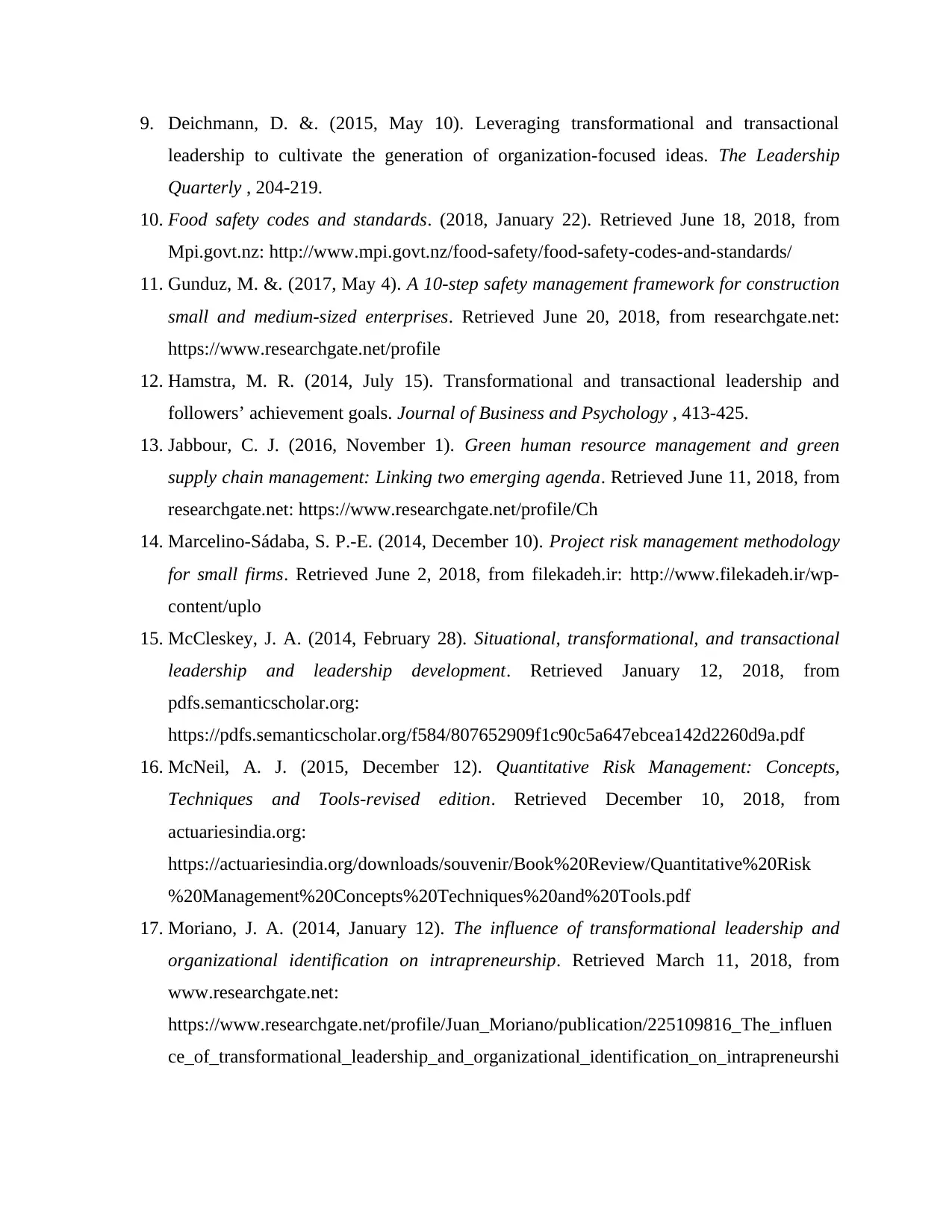
leadership to cultivate the generation of organization-focused ideas. The Leadership
Quarterly , 204-219.
10. Food safety codes and standards. (2018, January 22). Retrieved June 18, 2018, from
Mpi.govt.nz: http://www.mpi.govt.nz/food-safety/food-safety-codes-and-standards/
11. Gunduz, M. &. (2017, May 4). A 10-step safety management framework for construction
small and medium-sized enterprises. Retrieved June 20, 2018, from researchgate.net:
https://www.researchgate.net/profile
12. Hamstra, M. R. (2014, July 15). Transformational and transactional leadership and
followers’ achievement goals. Journal of Business and Psychology , 413-425.
13. Jabbour, C. J. (2016, November 1). Green human resource management and green
supply chain management: Linking two emerging agenda. Retrieved June 11, 2018, from
researchgate.net: https://www.researchgate.net/profile/Ch
14. Marcelino-Sádaba, S. P.-E. (2014, December 10). Project risk management methodology
for small firms. Retrieved June 2, 2018, from filekadeh.ir: http://www.filekadeh.ir/wp-
content/uplo
15. McCleskey, J. A. (2014, February 28). Situational, transformational, and transactional
leadership and leadership development. Retrieved January 12, 2018, from
pdfs.semanticscholar.org:
https://pdfs.semanticscholar.org/f584/807652909f1c90c5a647ebcea142d2260d9a.pdf
16. McNeil, A. J. (2015, December 12). Quantitative Risk Management: Concepts,
Techniques and Tools-revised edition. Retrieved December 10, 2018, from
actuariesindia.org:
https://actuariesindia.org/downloads/souvenir/Book%20Review/Quantitative%20Risk
%20Management%20Concepts%20Techniques%20and%20Tools.pdf
17. Moriano, J. A. (2014, January 12). The influence of transformational leadership and
organizational identification on intrapreneurship. Retrieved March 11, 2018, from
www.researchgate.net:
https://www.researchgate.net/profile/Juan_Moriano/publication/225109816_The_influen
ce_of_transformational_leadership_and_organizational_identification_on_intrapreneurshi
⊘ This is a preview!⊘
Do you want full access?
Subscribe today to unlock all pages.

Trusted by 1+ million students worldwide
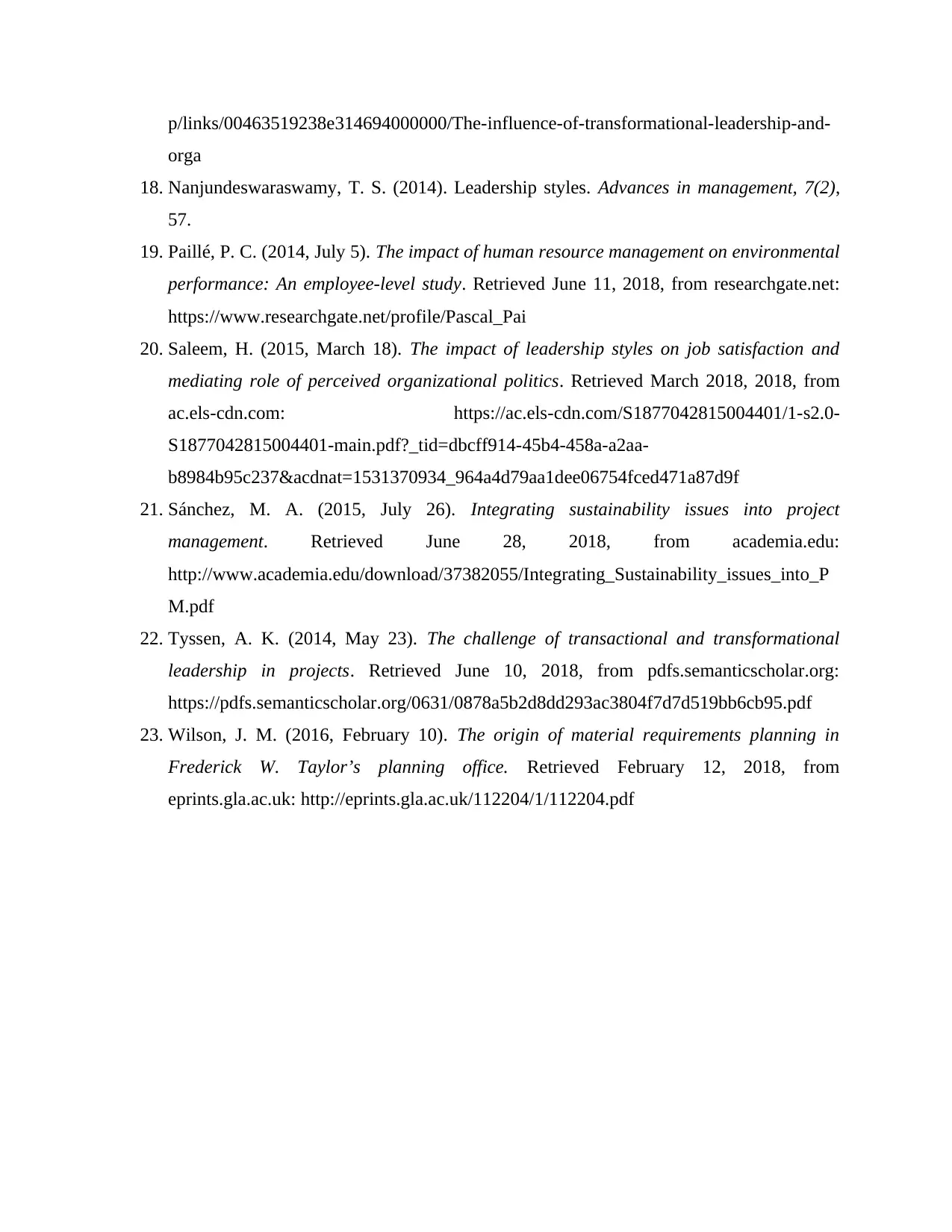
orga
18. Nanjundeswaraswamy, T. S. (2014). Leadership styles. Advances in management, 7(2),
57.
19. Paillé, P. C. (2014, July 5). The impact of human resource management on environmental
performance: An employee-level study. Retrieved June 11, 2018, from researchgate.net:
https://www.researchgate.net/profile/Pascal_Pai
20. Saleem, H. (2015, March 18). The impact of leadership styles on job satisfaction and
mediating role of perceived organizational politics. Retrieved March 2018, 2018, from
ac.els-cdn.com: https://ac.els-cdn.com/S1877042815004401/1-s2.0-
S1877042815004401-main.pdf?_tid=dbcff914-45b4-458a-a2aa-
b8984b95c237&acdnat=1531370934_964a4d79aa1dee06754fced471a87d9f
21. Sánchez, M. A. (2015, July 26). Integrating sustainability issues into project
management. Retrieved June 28, 2018, from academia.edu:
http://www.academia.edu/download/37382055/Integrating_Sustainability_issues_into_P
M.pdf
22. Tyssen, A. K. (2014, May 23). The challenge of transactional and transformational
leadership in projects. Retrieved June 10, 2018, from pdfs.semanticscholar.org:
https://pdfs.semanticscholar.org/0631/0878a5b2d8dd293ac3804f7d7d519bb6cb95.pdf
23. Wilson, J. M. (2016, February 10). The origin of material requirements planning in
Frederick W. Taylor’s planning office. Retrieved February 12, 2018, from
eprints.gla.ac.uk: http://eprints.gla.ac.uk/112204/1/112204.pdf
Your All-in-One AI-Powered Toolkit for Academic Success.
+13062052269
info@desklib.com
Available 24*7 on WhatsApp / Email
![[object Object]](/_next/static/media/star-bottom.7253800d.svg)
© 2024 | Zucol Services PVT LTD | All rights reserved.
